Blockchain Technology in IoT Assignment 2022
VerifiedAdded on 2022/10/11
|16
|5394
|7
Assignment
AI Summary
Contribute Materials
Your contribution can guide someone’s learning journey. Share your
documents today.
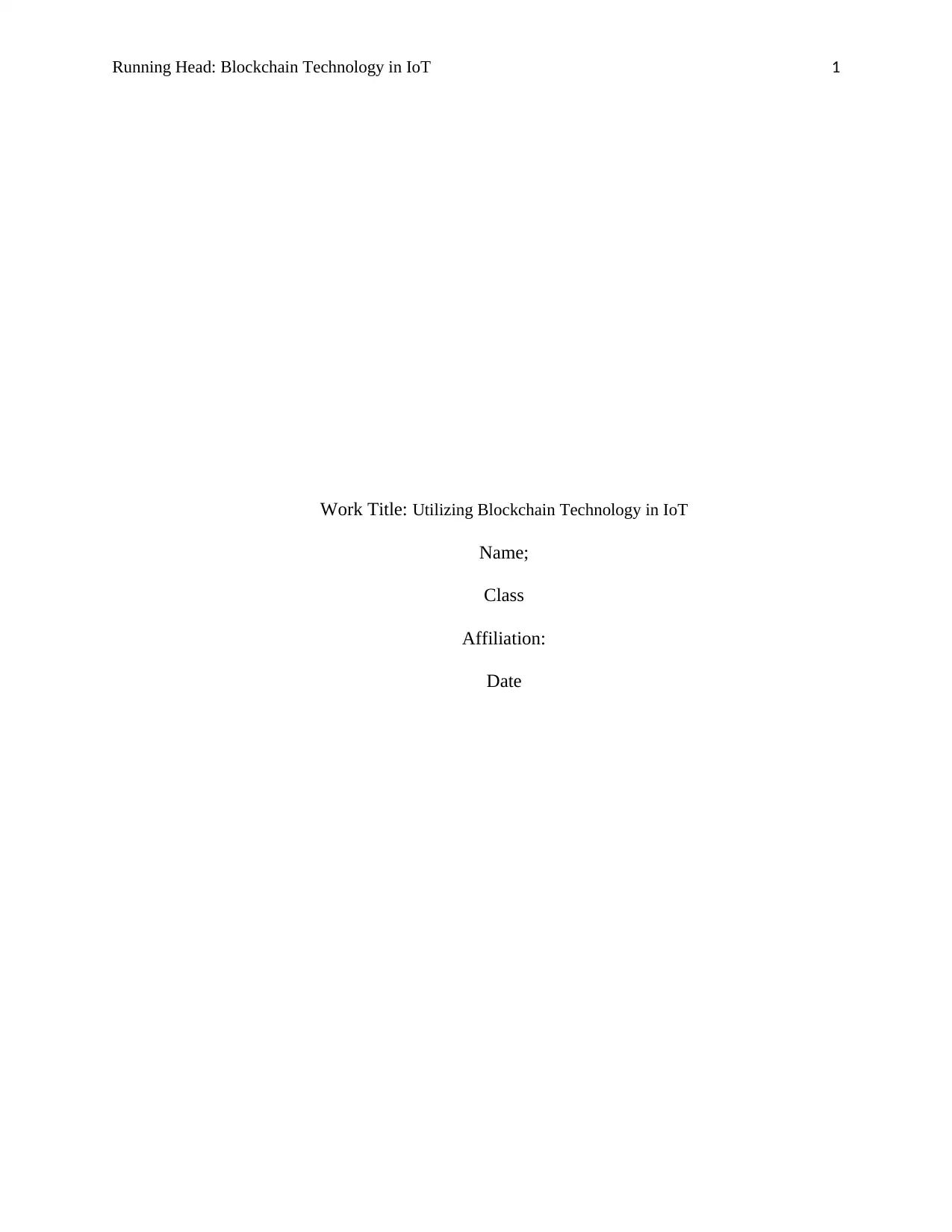
Running Head: Blockchain Technology in IoT 1
Work Title: Utilizing Blockchain Technology in IoT
Name;
Class
Affiliation:
Date
Work Title: Utilizing Blockchain Technology in IoT
Name;
Class
Affiliation:
Date
Secure Best Marks with AI Grader
Need help grading? Try our AI Grader for instant feedback on your assignments.
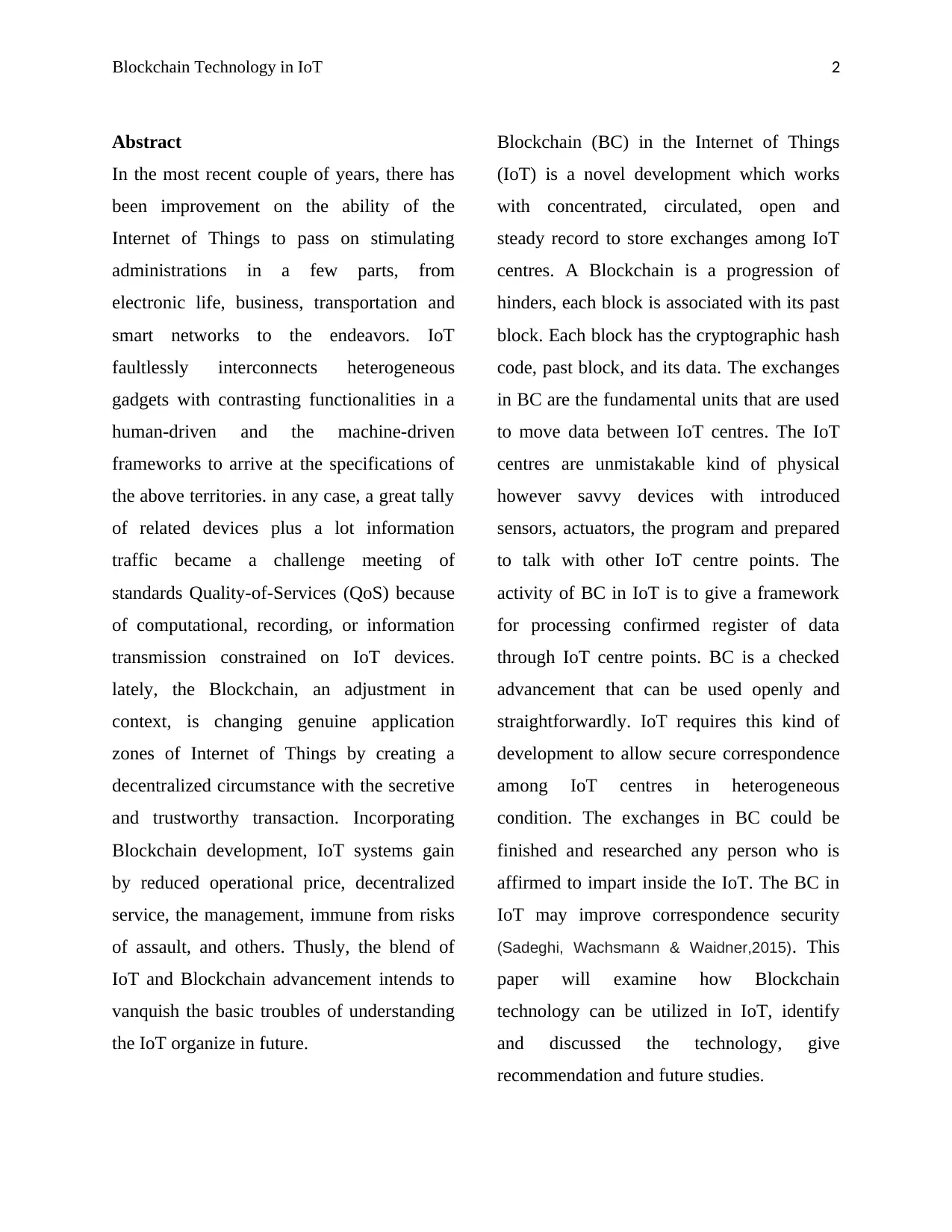
Blockchain Technology in IoT 2
Abstract
In the most recent couple of years, there has
been improvement on the ability of the
Internet of Things to pass on stimulating
administrations in a few parts, from
electronic life, business, transportation and
smart networks to the endeavors. IoT
faultlessly interconnects heterogeneous
gadgets with contrasting functionalities in a
human-driven and the machine-driven
frameworks to arrive at the specifications of
the above territories. in any case, a great tally
of related devices plus a lot information
traffic became a challenge meeting of
standards Quality-of-Services (QoS) because
of computational, recording, or information
transmission constrained on IoT devices.
lately, the Blockchain, an adjustment in
context, is changing genuine application
zones of Internet of Things by creating a
decentralized circumstance with the secretive
and trustworthy transaction. Incorporating
Blockchain development, IoT systems gain
by reduced operational price, decentralized
service, the management, immune from risks
of assault, and others. Thusly, the blend of
IoT and Blockchain advancement intends to
vanquish the basic troubles of understanding
the IoT organize in future.
Blockchain (BC) in the Internet of Things
(IoT) is a novel development which works
with concentrated, circulated, open and
steady record to store exchanges among IoT
centres. A Blockchain is a progression of
hinders, each block is associated with its past
block. Each block has the cryptographic hash
code, past block, and its data. The exchanges
in BC are the fundamental units that are used
to move data between IoT centres. The IoT
centres are unmistakable kind of physical
however savvy devices with introduced
sensors, actuators, the program and prepared
to talk with other IoT centre points. The
activity of BC in IoT is to give a framework
for processing confirmed register of data
through IoT centre points. BC is a checked
advancement that can be used openly and
straightforwardly. IoT requires this kind of
development to allow secure correspondence
among IoT centres in heterogeneous
condition. The exchanges in BC could be
finished and researched any person who is
affirmed to impart inside the IoT. The BC in
IoT may improve correspondence security
(Sadeghi, Wachsmann & Waidner,2015). This
paper will examine how Blockchain
technology can be utilized in IoT, identify
and discussed the technology, give
recommendation and future studies.
Abstract
In the most recent couple of years, there has
been improvement on the ability of the
Internet of Things to pass on stimulating
administrations in a few parts, from
electronic life, business, transportation and
smart networks to the endeavors. IoT
faultlessly interconnects heterogeneous
gadgets with contrasting functionalities in a
human-driven and the machine-driven
frameworks to arrive at the specifications of
the above territories. in any case, a great tally
of related devices plus a lot information
traffic became a challenge meeting of
standards Quality-of-Services (QoS) because
of computational, recording, or information
transmission constrained on IoT devices.
lately, the Blockchain, an adjustment in
context, is changing genuine application
zones of Internet of Things by creating a
decentralized circumstance with the secretive
and trustworthy transaction. Incorporating
Blockchain development, IoT systems gain
by reduced operational price, decentralized
service, the management, immune from risks
of assault, and others. Thusly, the blend of
IoT and Blockchain advancement intends to
vanquish the basic troubles of understanding
the IoT organize in future.
Blockchain (BC) in the Internet of Things
(IoT) is a novel development which works
with concentrated, circulated, open and
steady record to store exchanges among IoT
centres. A Blockchain is a progression of
hinders, each block is associated with its past
block. Each block has the cryptographic hash
code, past block, and its data. The exchanges
in BC are the fundamental units that are used
to move data between IoT centres. The IoT
centres are unmistakable kind of physical
however savvy devices with introduced
sensors, actuators, the program and prepared
to talk with other IoT centre points. The
activity of BC in IoT is to give a framework
for processing confirmed register of data
through IoT centre points. BC is a checked
advancement that can be used openly and
straightforwardly. IoT requires this kind of
development to allow secure correspondence
among IoT centres in heterogeneous
condition. The exchanges in BC could be
finished and researched any person who is
affirmed to impart inside the IoT. The BC in
IoT may improve correspondence security
(Sadeghi, Wachsmann & Waidner,2015). This
paper will examine how Blockchain
technology can be utilized in IoT, identify
and discussed the technology, give
recommendation and future studies.
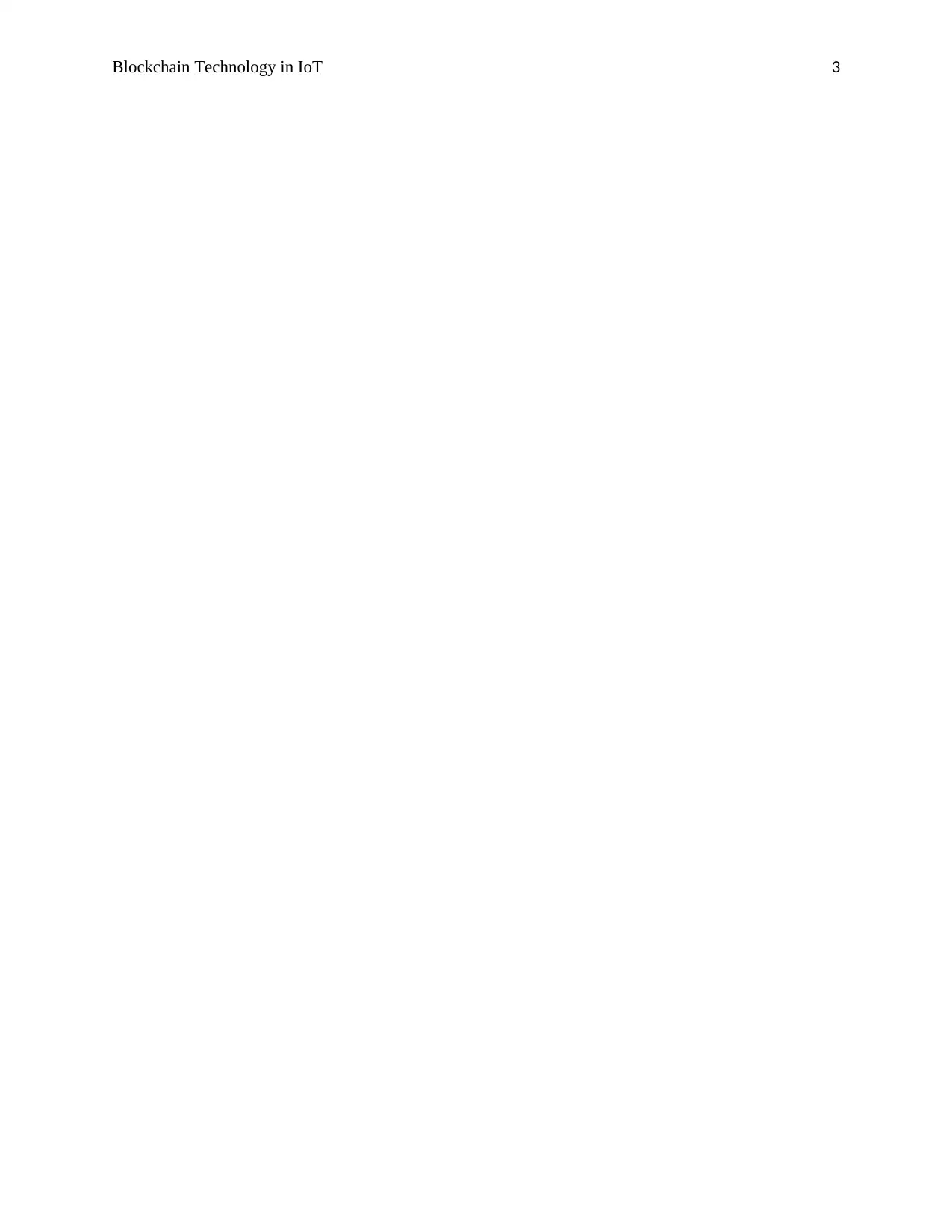
Blockchain Technology in IoT 3
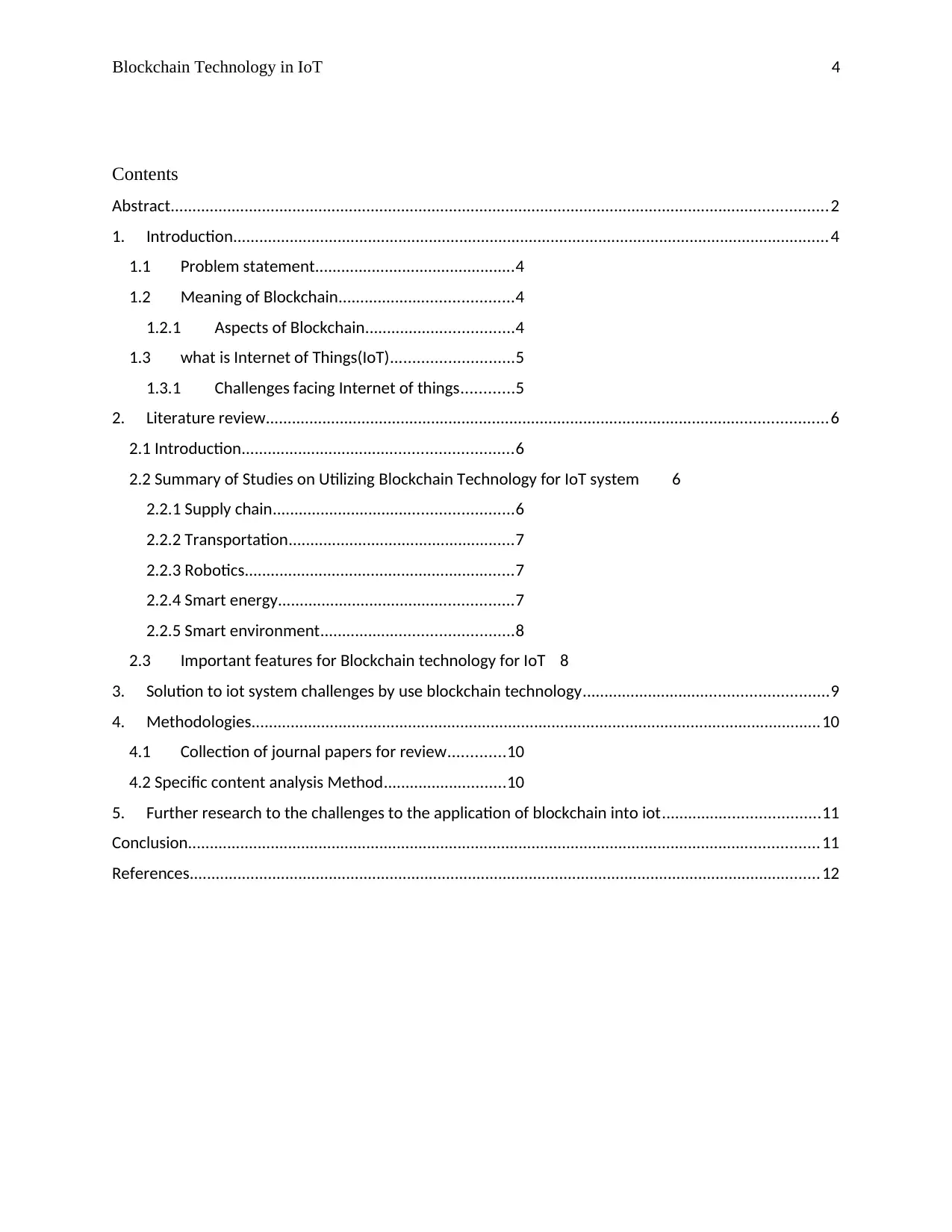
Blockchain Technology in IoT 4
Contents
Abstract.......................................................................................................................................................2
1. Introduction.........................................................................................................................................4
1.1 Problem statement..............................................4
1.2 Meaning of Blockchain........................................4
1.2.1 Aspects of Blockchain..................................4
1.3 what is Internet of Things(IoT)............................5
1.3.1 Challenges facing Internet of things............5
2. Literature review.................................................................................................................................6
2.1 Introduction..............................................................6
2.2 Summary of Studies on Utilizing Blockchain Technology for IoT system 6
2.2.1 Supply chain.......................................................6
2.2.2 Transportation....................................................7
2.2.3 Robotics..............................................................7
2.2.4 Smart energy......................................................7
2.2.5 Smart environment............................................8
2.3 Important features for Blockchain technology for IoT 8
3. Solution to iot system challenges by use blockchain technology........................................................9
4. Methodologies...................................................................................................................................10
4.1 Collection of journal papers for review.............10
4.2 Specific content analysis Method............................10
5. Further research to the challenges to the application of blockchain into iot....................................11
Conclusion.................................................................................................................................................11
References.................................................................................................................................................12
Contents
Abstract.......................................................................................................................................................2
1. Introduction.........................................................................................................................................4
1.1 Problem statement..............................................4
1.2 Meaning of Blockchain........................................4
1.2.1 Aspects of Blockchain..................................4
1.3 what is Internet of Things(IoT)............................5
1.3.1 Challenges facing Internet of things............5
2. Literature review.................................................................................................................................6
2.1 Introduction..............................................................6
2.2 Summary of Studies on Utilizing Blockchain Technology for IoT system 6
2.2.1 Supply chain.......................................................6
2.2.2 Transportation....................................................7
2.2.3 Robotics..............................................................7
2.2.4 Smart energy......................................................7
2.2.5 Smart environment............................................8
2.3 Important features for Blockchain technology for IoT 8
3. Solution to iot system challenges by use blockchain technology........................................................9
4. Methodologies...................................................................................................................................10
4.1 Collection of journal papers for review.............10
4.2 Specific content analysis Method............................10
5. Further research to the challenges to the application of blockchain into iot....................................11
Conclusion.................................................................................................................................................11
References.................................................................................................................................................12
Secure Best Marks with AI Grader
Need help grading? Try our AI Grader for instant feedback on your assignments.
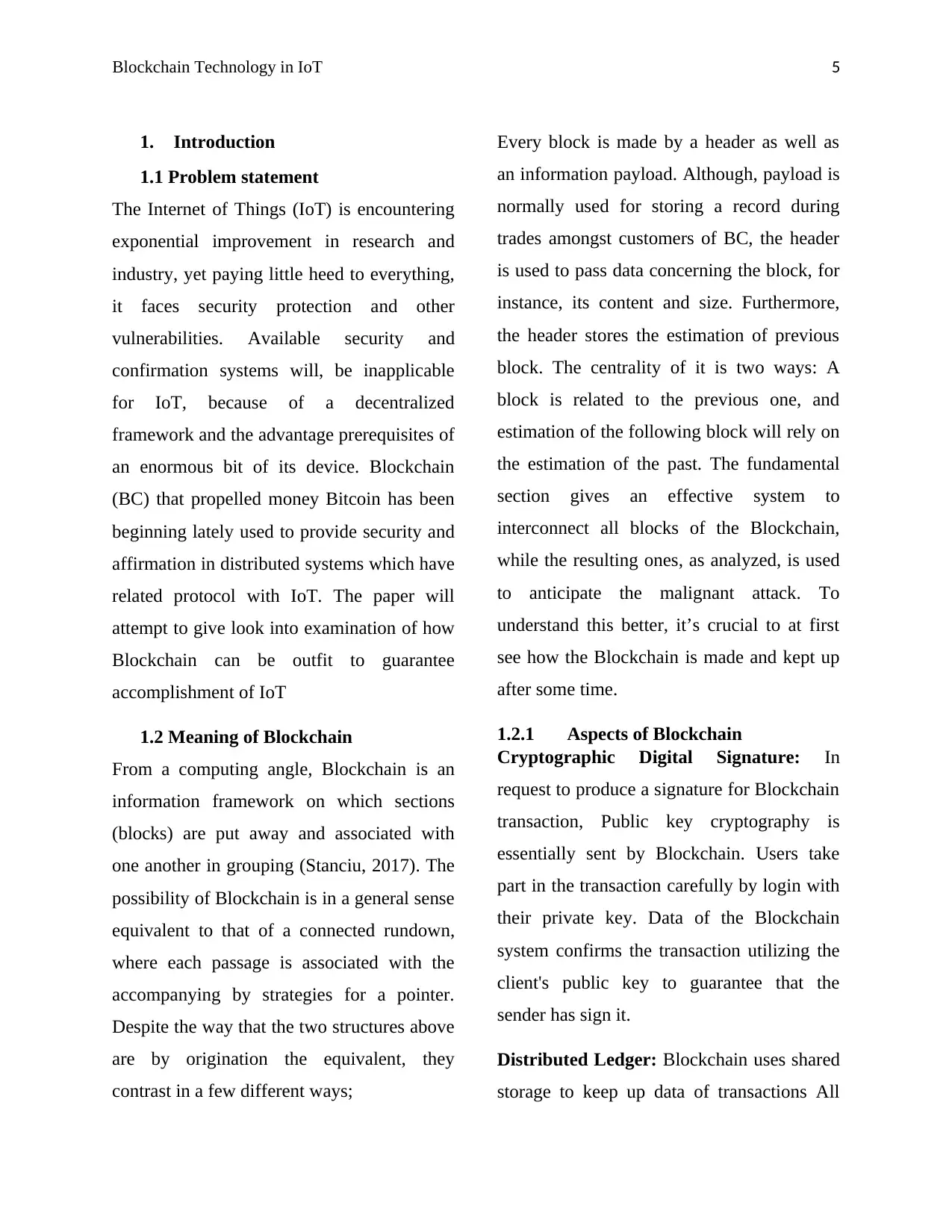
Blockchain Technology in IoT 5
1. Introduction
1.1 Problem statement
The Internet of Things (IoT) is encountering
exponential improvement in research and
industry, yet paying little heed to everything,
it faces security protection and other
vulnerabilities. Available security and
confirmation systems will, be inapplicable
for IoT, because of a decentralized
framework and the advantage prerequisites of
an enormous bit of its device. Blockchain
(BC) that propelled money Bitcoin has been
beginning lately used to provide security and
affirmation in distributed systems which have
related protocol with IoT. The paper will
attempt to give look into examination of how
Blockchain can be outfit to guarantee
accomplishment of IoT
1.2 Meaning of Blockchain
From a computing angle, Blockchain is an
information framework on which sections
(blocks) are put away and associated with
one another in grouping (Stanciu, 2017). The
possibility of Blockchain is in a general sense
equivalent to that of a connected rundown,
where each passage is associated with the
accompanying by strategies for a pointer.
Despite the way that the two structures above
are by origination the equivalent, they
contrast in a few different ways;
Every block is made by a header as well as
an information payload. Although, payload is
normally used for storing a record during
trades amongst customers of BC, the header
is used to pass data concerning the block, for
instance, its content and size. Furthermore,
the header stores the estimation of previous
block. The centrality of it is two ways: A
block is related to the previous one, and
estimation of the following block will rely on
the estimation of the past. The fundamental
section gives an effective system to
interconnect all blocks of the Blockchain,
while the resulting ones, as analyzed, is used
to anticipate the malignant attack. To
understand this better, it’s crucial to at first
see how the Blockchain is made and kept up
after some time.
1.2.1 Aspects of Blockchain
Cryptographic Digital Signature: In
request to produce a signature for Blockchain
transaction, Public key cryptography is
essentially sent by Blockchain. Users take
part in the transaction carefully by login with
their private key. Data of the Blockchain
system confirms the transaction utilizing the
client's public key to guarantee that the
sender has sign it.
Distributed Ledger: Blockchain uses shared
storage to keep up data of transactions All
1. Introduction
1.1 Problem statement
The Internet of Things (IoT) is encountering
exponential improvement in research and
industry, yet paying little heed to everything,
it faces security protection and other
vulnerabilities. Available security and
confirmation systems will, be inapplicable
for IoT, because of a decentralized
framework and the advantage prerequisites of
an enormous bit of its device. Blockchain
(BC) that propelled money Bitcoin has been
beginning lately used to provide security and
affirmation in distributed systems which have
related protocol with IoT. The paper will
attempt to give look into examination of how
Blockchain can be outfit to guarantee
accomplishment of IoT
1.2 Meaning of Blockchain
From a computing angle, Blockchain is an
information framework on which sections
(blocks) are put away and associated with
one another in grouping (Stanciu, 2017). The
possibility of Blockchain is in a general sense
equivalent to that of a connected rundown,
where each passage is associated with the
accompanying by strategies for a pointer.
Despite the way that the two structures above
are by origination the equivalent, they
contrast in a few different ways;
Every block is made by a header as well as
an information payload. Although, payload is
normally used for storing a record during
trades amongst customers of BC, the header
is used to pass data concerning the block, for
instance, its content and size. Furthermore,
the header stores the estimation of previous
block. The centrality of it is two ways: A
block is related to the previous one, and
estimation of the following block will rely on
the estimation of the past. The fundamental
section gives an effective system to
interconnect all blocks of the Blockchain,
while the resulting ones, as analyzed, is used
to anticipate the malignant attack. To
understand this better, it’s crucial to at first
see how the Blockchain is made and kept up
after some time.
1.2.1 Aspects of Blockchain
Cryptographic Digital Signature: In
request to produce a signature for Blockchain
transaction, Public key cryptography is
essentially sent by Blockchain. Users take
part in the transaction carefully by login with
their private key. Data of the Blockchain
system confirms the transaction utilizing the
client's public key to guarantee that the
sender has sign it.
Distributed Ledger: Blockchain uses shared
storage to keep up data of transactions All
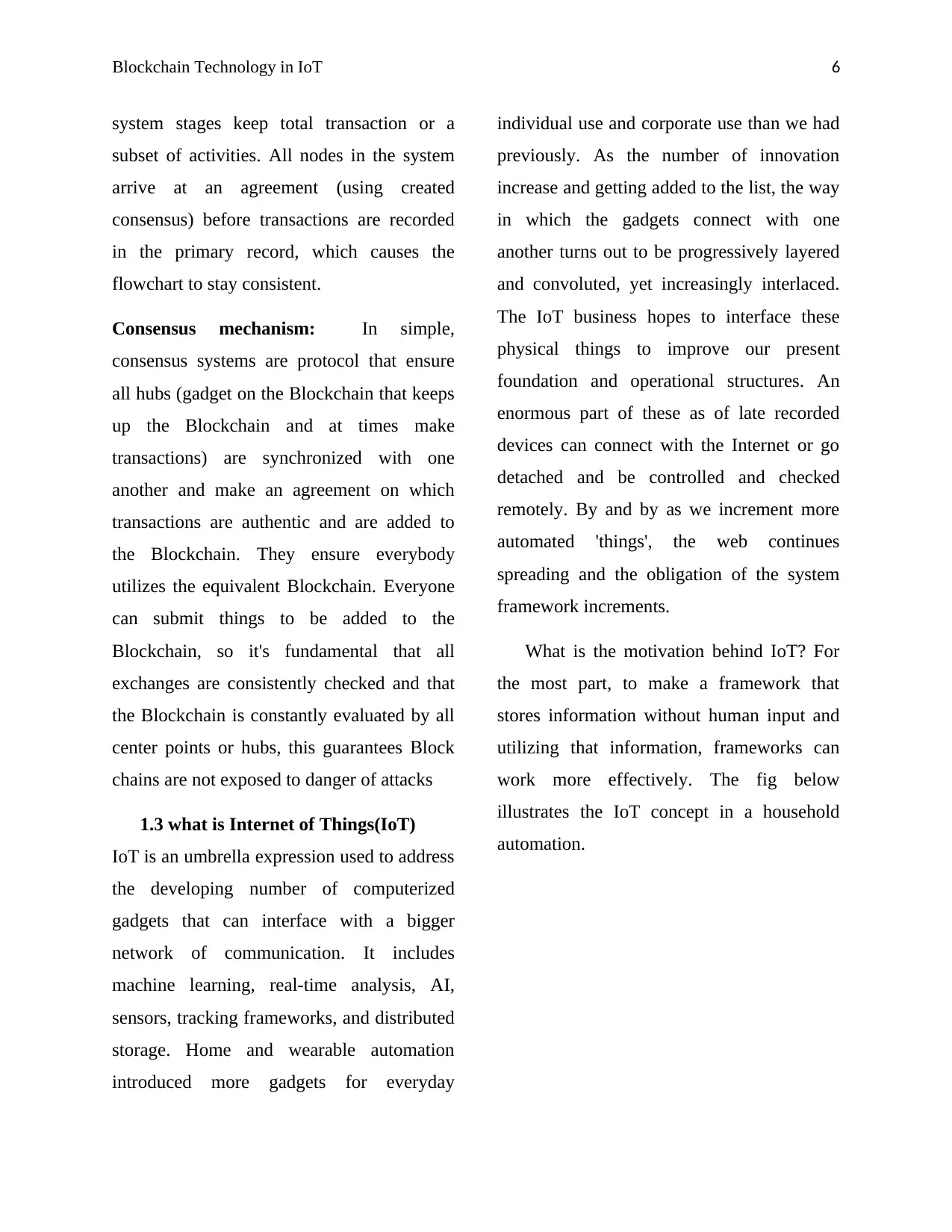
Blockchain Technology in IoT 6
system stages keep total transaction or a
subset of activities. All nodes in the system
arrive at an agreement (using created
consensus) before transactions are recorded
in the primary record, which causes the
flowchart to stay consistent.
Consensus mechanism: In simple,
consensus systems are protocol that ensure
all hubs (gadget on the Blockchain that keeps
up the Blockchain and at times make
transactions) are synchronized with one
another and make an agreement on which
transactions are authentic and are added to
the Blockchain. They ensure everybody
utilizes the equivalent Blockchain. Everyone
can submit things to be added to the
Blockchain, so it's fundamental that all
exchanges are consistently checked and that
the Blockchain is constantly evaluated by all
center points or hubs, this guarantees Block
chains are not exposed to danger of attacks
1.3 what is Internet of Things(IoT)
IoT is an umbrella expression used to address
the developing number of computerized
gadgets that can interface with a bigger
network of communication. It includes
machine learning, real-time analysis, AI,
sensors, tracking frameworks, and distributed
storage. Home and wearable automation
introduced more gadgets for everyday
individual use and corporate use than we had
previously. As the number of innovation
increase and getting added to the list, the way
in which the gadgets connect with one
another turns out to be progressively layered
and convoluted, yet increasingly interlaced.
The IoT business hopes to interface these
physical things to improve our present
foundation and operational structures. An
enormous part of these as of late recorded
devices can connect with the Internet or go
detached and be controlled and checked
remotely. By and by as we increment more
automated 'things', the web continues
spreading and the obligation of the system
framework increments.
What is the motivation behind IoT? For
the most part, to make a framework that
stores information without human input and
utilizing that information, frameworks can
work more effectively. The fig below
illustrates the IoT concept in a household
automation.
system stages keep total transaction or a
subset of activities. All nodes in the system
arrive at an agreement (using created
consensus) before transactions are recorded
in the primary record, which causes the
flowchart to stay consistent.
Consensus mechanism: In simple,
consensus systems are protocol that ensure
all hubs (gadget on the Blockchain that keeps
up the Blockchain and at times make
transactions) are synchronized with one
another and make an agreement on which
transactions are authentic and are added to
the Blockchain. They ensure everybody
utilizes the equivalent Blockchain. Everyone
can submit things to be added to the
Blockchain, so it's fundamental that all
exchanges are consistently checked and that
the Blockchain is constantly evaluated by all
center points or hubs, this guarantees Block
chains are not exposed to danger of attacks
1.3 what is Internet of Things(IoT)
IoT is an umbrella expression used to address
the developing number of computerized
gadgets that can interface with a bigger
network of communication. It includes
machine learning, real-time analysis, AI,
sensors, tracking frameworks, and distributed
storage. Home and wearable automation
introduced more gadgets for everyday
individual use and corporate use than we had
previously. As the number of innovation
increase and getting added to the list, the way
in which the gadgets connect with one
another turns out to be progressively layered
and convoluted, yet increasingly interlaced.
The IoT business hopes to interface these
physical things to improve our present
foundation and operational structures. An
enormous part of these as of late recorded
devices can connect with the Internet or go
detached and be controlled and checked
remotely. By and by as we increment more
automated 'things', the web continues
spreading and the obligation of the system
framework increments.
What is the motivation behind IoT? For
the most part, to make a framework that
stores information without human input and
utilizing that information, frameworks can
work more effectively. The fig below
illustrates the IoT concept in a household
automation.
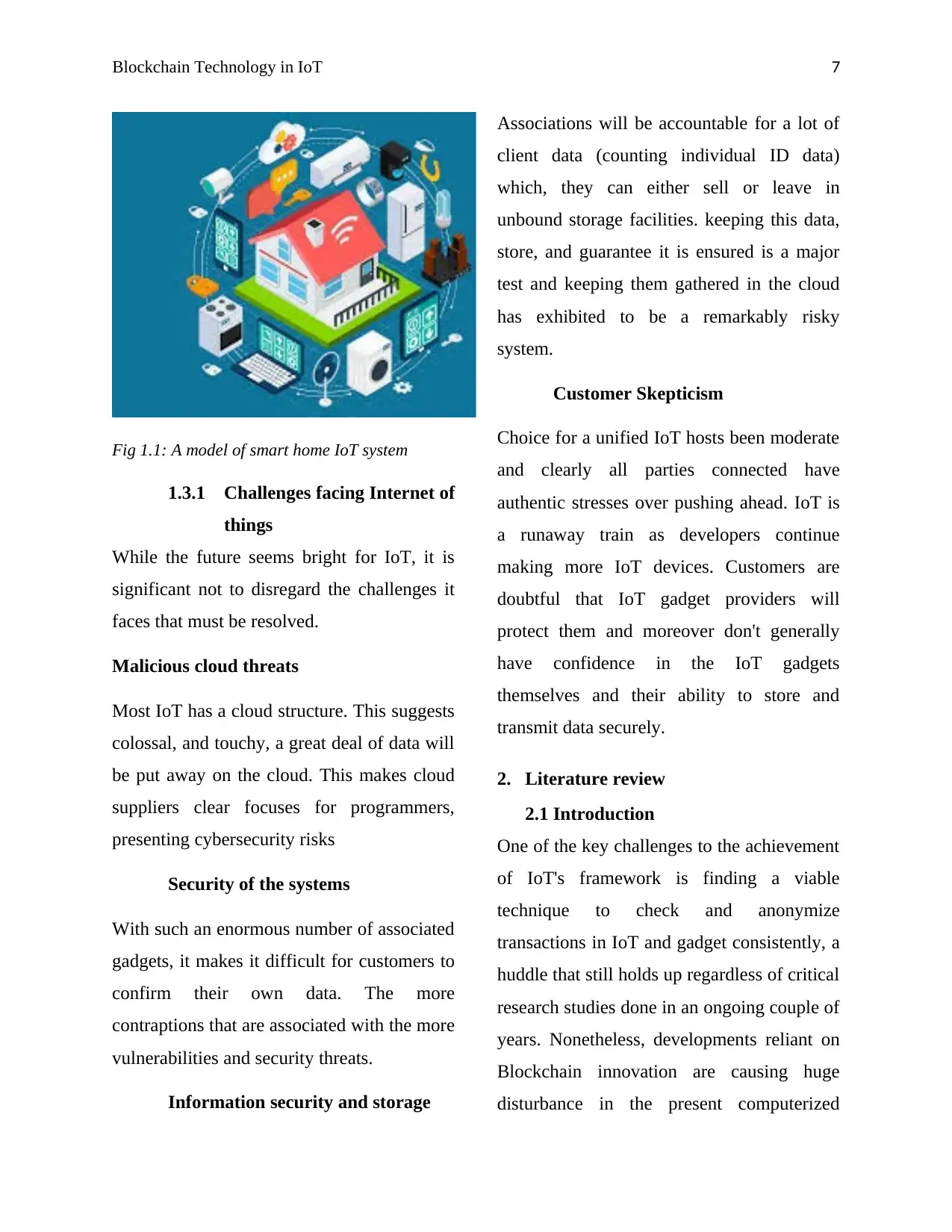
Blockchain Technology in IoT 7
Fig 1.1: A model of smart home IoT system
1.3.1 Challenges facing Internet of
things
While the future seems bright for IoT, it is
significant not to disregard the challenges it
faces that must be resolved.
Malicious cloud threats
Most IoT has a cloud structure. This suggests
colossal, and touchy, a great deal of data will
be put away on the cloud. This makes cloud
suppliers clear focuses for programmers,
presenting cybersecurity risks
Security of the systems
With such an enormous number of associated
gadgets, it makes it difficult for customers to
confirm their own data. The more
contraptions that are associated with the more
vulnerabilities and security threats.
Information security and storage
Associations will be accountable for a lot of
client data (counting individual ID data)
which, they can either sell or leave in
unbound storage facilities. keeping this data,
store, and guarantee it is ensured is a major
test and keeping them gathered in the cloud
has exhibited to be a remarkably risky
system.
Customer Skepticism
Choice for a unified IoT hosts been moderate
and clearly all parties connected have
authentic stresses over pushing ahead. IoT is
a runaway train as developers continue
making more IoT devices. Customers are
doubtful that IoT gadget providers will
protect them and moreover don't generally
have confidence in the IoT gadgets
themselves and their ability to store and
transmit data securely.
2. Literature review
2.1 Introduction
One of the key challenges to the achievement
of IoT's framework is finding a viable
technique to check and anonymize
transactions in IoT and gadget consistently, a
huddle that still holds up regardless of critical
research studies done in an ongoing couple of
years. Nonetheless, developments reliant on
Blockchain innovation are causing huge
disturbance in the present computerized
Fig 1.1: A model of smart home IoT system
1.3.1 Challenges facing Internet of
things
While the future seems bright for IoT, it is
significant not to disregard the challenges it
faces that must be resolved.
Malicious cloud threats
Most IoT has a cloud structure. This suggests
colossal, and touchy, a great deal of data will
be put away on the cloud. This makes cloud
suppliers clear focuses for programmers,
presenting cybersecurity risks
Security of the systems
With such an enormous number of associated
gadgets, it makes it difficult for customers to
confirm their own data. The more
contraptions that are associated with the more
vulnerabilities and security threats.
Information security and storage
Associations will be accountable for a lot of
client data (counting individual ID data)
which, they can either sell or leave in
unbound storage facilities. keeping this data,
store, and guarantee it is ensured is a major
test and keeping them gathered in the cloud
has exhibited to be a remarkably risky
system.
Customer Skepticism
Choice for a unified IoT hosts been moderate
and clearly all parties connected have
authentic stresses over pushing ahead. IoT is
a runaway train as developers continue
making more IoT devices. Customers are
doubtful that IoT gadget providers will
protect them and moreover don't generally
have confidence in the IoT gadgets
themselves and their ability to store and
transmit data securely.
2. Literature review
2.1 Introduction
One of the key challenges to the achievement
of IoT's framework is finding a viable
technique to check and anonymize
transactions in IoT and gadget consistently, a
huddle that still holds up regardless of critical
research studies done in an ongoing couple of
years. Nonetheless, developments reliant on
Blockchain innovation are causing huge
disturbance in the present computerized
Paraphrase This Document
Need a fresh take? Get an instant paraphrase of this document with our AI Paraphraser
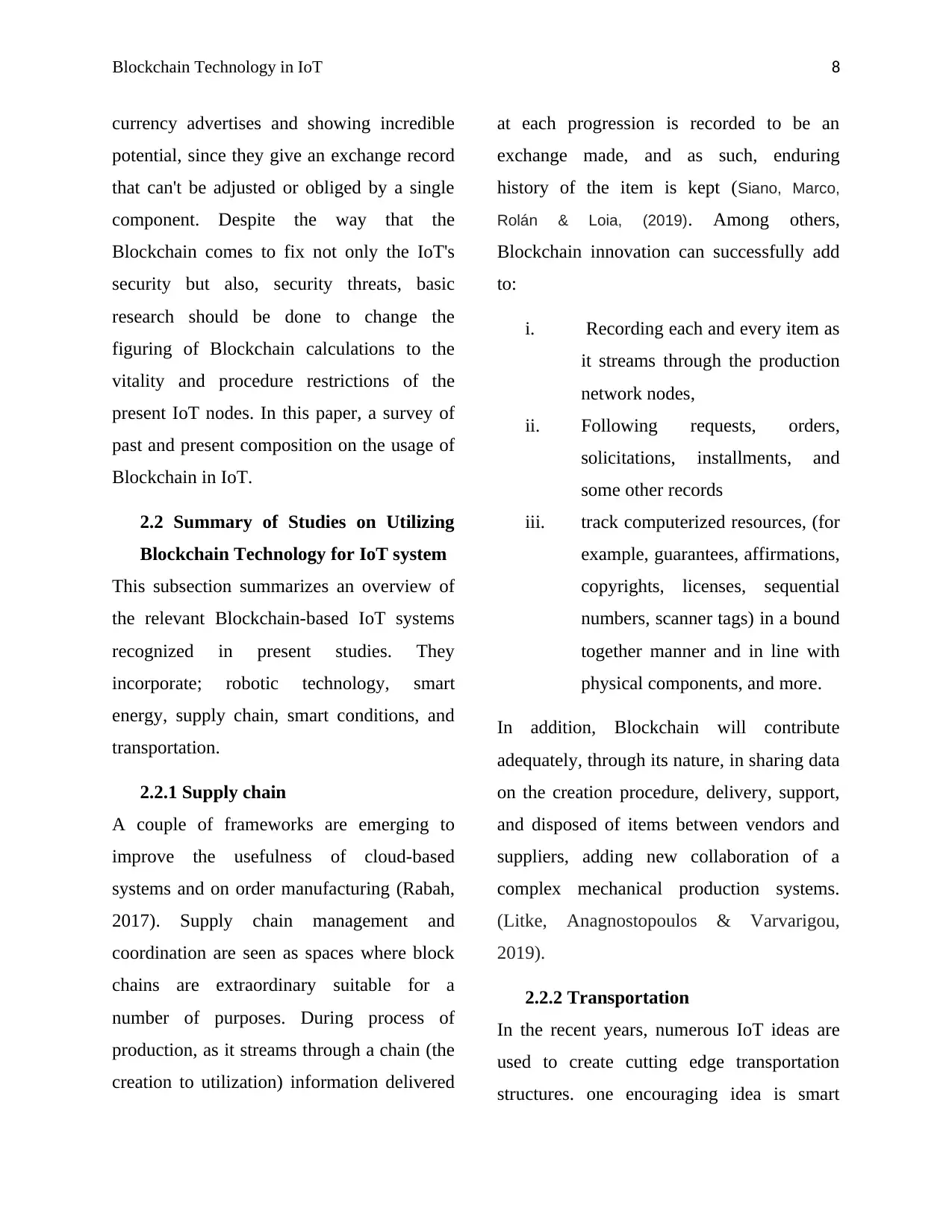
Blockchain Technology in IoT 8
currency advertises and showing incredible
potential, since they give an exchange record
that can't be adjusted or obliged by a single
component. Despite the way that the
Blockchain comes to fix not only the IoT's
security but also, security threats, basic
research should be done to change the
figuring of Blockchain calculations to the
vitality and procedure restrictions of the
present IoT nodes. In this paper, a survey of
past and present composition on the usage of
Blockchain in IoT.
2.2 Summary of Studies on Utilizing
Blockchain Technology for IoT system
This subsection summarizes an overview of
the relevant Blockchain-based IoT systems
recognized in present studies. They
incorporate; robotic technology, smart
energy, supply chain, smart conditions, and
transportation.
2.2.1 Supply chain
A couple of frameworks are emerging to
improve the usefulness of cloud-based
systems and on order manufacturing (Rabah,
2017). Supply chain management and
coordination are seen as spaces where block
chains are extraordinary suitable for a
number of purposes. During process of
production, as it streams through a chain (the
creation to utilization) information delivered
at each progression is recorded to be an
exchange made, and as such, enduring
history of the item is kept (Siano, Marco,
Rolán & Loia, (2019). Among others,
Blockchain innovation can successfully add
to:
i. Recording each and every item as
it streams through the production
network nodes,
ii. Following requests, orders,
solicitations, installments, and
some other records
iii. track computerized resources, (for
example, guarantees, affirmations,
copyrights, licenses, sequential
numbers, scanner tags) in a bound
together manner and in line with
physical components, and more.
In addition, Blockchain will contribute
adequately, through its nature, in sharing data
on the creation procedure, delivery, support,
and disposed of items between vendors and
suppliers, adding new collaboration of a
complex mechanical production systems.
(Litke, Anagnostopoulos & Varvarigou,
2019).
2.2.2 Transportation
In the recent years, numerous IoT ideas are
used to create cutting edge transportation
structures. one encouraging idea is smart
currency advertises and showing incredible
potential, since they give an exchange record
that can't be adjusted or obliged by a single
component. Despite the way that the
Blockchain comes to fix not only the IoT's
security but also, security threats, basic
research should be done to change the
figuring of Blockchain calculations to the
vitality and procedure restrictions of the
present IoT nodes. In this paper, a survey of
past and present composition on the usage of
Blockchain in IoT.
2.2 Summary of Studies on Utilizing
Blockchain Technology for IoT system
This subsection summarizes an overview of
the relevant Blockchain-based IoT systems
recognized in present studies. They
incorporate; robotic technology, smart
energy, supply chain, smart conditions, and
transportation.
2.2.1 Supply chain
A couple of frameworks are emerging to
improve the usefulness of cloud-based
systems and on order manufacturing (Rabah,
2017). Supply chain management and
coordination are seen as spaces where block
chains are extraordinary suitable for a
number of purposes. During process of
production, as it streams through a chain (the
creation to utilization) information delivered
at each progression is recorded to be an
exchange made, and as such, enduring
history of the item is kept (Siano, Marco,
Rolán & Loia, (2019). Among others,
Blockchain innovation can successfully add
to:
i. Recording each and every item as
it streams through the production
network nodes,
ii. Following requests, orders,
solicitations, installments, and
some other records
iii. track computerized resources, (for
example, guarantees, affirmations,
copyrights, licenses, sequential
numbers, scanner tags) in a bound
together manner and in line with
physical components, and more.
In addition, Blockchain will contribute
adequately, through its nature, in sharing data
on the creation procedure, delivery, support,
and disposed of items between vendors and
suppliers, adding new collaboration of a
complex mechanical production systems.
(Litke, Anagnostopoulos & Varvarigou,
2019).
2.2.2 Transportation
In the recent years, numerous IoT ideas are
used to create cutting edge transportation
structures. one encouraging idea is smart

Blockchain Technology in IoT 9
vehicles probably will not be computationally
obliged compared to rest of the IoT devices,
for example, sensor stages. Along these lines,
the Blockchain is a solid possibility to turn
into a system for carefully designed exchange
of information amongst smart vehicles
(Steger, Dorri, Kanhere, Romer, Jurdak &
Karner, 2018). Additionally, use the
Blockchain to plan an intelligent
transportation architecture, which
incorporates application, contract, consensus,
information, physical, and the network
system layers (Yuan & Wang, 2016). The
Blockchain has likewise been utilized to
execute frameworks to deal with the open
keys for a vehicles and by and large
exchange information in absence of third
party incorporated system (Rowan, Clear,
Gerla, Huggard & Goldrick, 2017). (Li, Liu,
Cheng, Qiu, Wang, Zhang, & Zhang 2018)
creates a narrative of a CreditCoin, a system
of privacy to exchange vital data (accidents,
traffic) where members are compensated
through cash.
2.2.3 Robotics
Present literature in robot technology uses
BC framework to help secure unmanned air
vehicles (UAV) communication. For sure,
UAV have to dependably organize activities,
exchange information, cooperatively decide.
(Sharma, You & Kul, 2017) propose a
framework in which drones can be modified
to utilize BC to safely pass data.
Additionally, (Ferrer, 2018) examine the
utilization of the Blockchain to give security,
self-governance and group basic leadership in
swarm robotic frameworks. The creators
utilize a mix of Blockchain as well as cloud
computing to ensure the reliability of
information gathered by drone.
2.2.4 Smart energy
This field has pulled in great attention from
IoT researchers. Most of the proposed IoT
frameworks use the Blockchain for;
safeguarding the security clients
with their own data;
securing framework against
malevolent transaction, for
example, clients trying to sell or
purchase excessive energy
(Mylrea & Gourisetti, 2017)
The authors (Hahn, Singh, Liu & Chen,
2017) propose an auction framework where
clients can offer to sell the highest bidder
their surplus energy through a structured
smart contract, subsequently wiping out the
requirement for a broker. (Yan, Huang, &
Hong, 2017). investigated the utilization of
Blockchain to reproduce the current
transactions to permit decentralized real-time
vehicles probably will not be computationally
obliged compared to rest of the IoT devices,
for example, sensor stages. Along these lines,
the Blockchain is a solid possibility to turn
into a system for carefully designed exchange
of information amongst smart vehicles
(Steger, Dorri, Kanhere, Romer, Jurdak &
Karner, 2018). Additionally, use the
Blockchain to plan an intelligent
transportation architecture, which
incorporates application, contract, consensus,
information, physical, and the network
system layers (Yuan & Wang, 2016). The
Blockchain has likewise been utilized to
execute frameworks to deal with the open
keys for a vehicles and by and large
exchange information in absence of third
party incorporated system (Rowan, Clear,
Gerla, Huggard & Goldrick, 2017). (Li, Liu,
Cheng, Qiu, Wang, Zhang, & Zhang 2018)
creates a narrative of a CreditCoin, a system
of privacy to exchange vital data (accidents,
traffic) where members are compensated
through cash.
2.2.3 Robotics
Present literature in robot technology uses
BC framework to help secure unmanned air
vehicles (UAV) communication. For sure,
UAV have to dependably organize activities,
exchange information, cooperatively decide.
(Sharma, You & Kul, 2017) propose a
framework in which drones can be modified
to utilize BC to safely pass data.
Additionally, (Ferrer, 2018) examine the
utilization of the Blockchain to give security,
self-governance and group basic leadership in
swarm robotic frameworks. The creators
utilize a mix of Blockchain as well as cloud
computing to ensure the reliability of
information gathered by drone.
2.2.4 Smart energy
This field has pulled in great attention from
IoT researchers. Most of the proposed IoT
frameworks use the Blockchain for;
safeguarding the security clients
with their own data;
securing framework against
malevolent transaction, for
example, clients trying to sell or
purchase excessive energy
(Mylrea & Gourisetti, 2017)
The authors (Hahn, Singh, Liu & Chen,
2017) propose an auction framework where
clients can offer to sell the highest bidder
their surplus energy through a structured
smart contract, subsequently wiping out the
requirement for a broker. (Yan, Huang, &
Hong, 2017). investigated the utilization of
Blockchain to reproduce the current
transactions to permit decentralized real-time
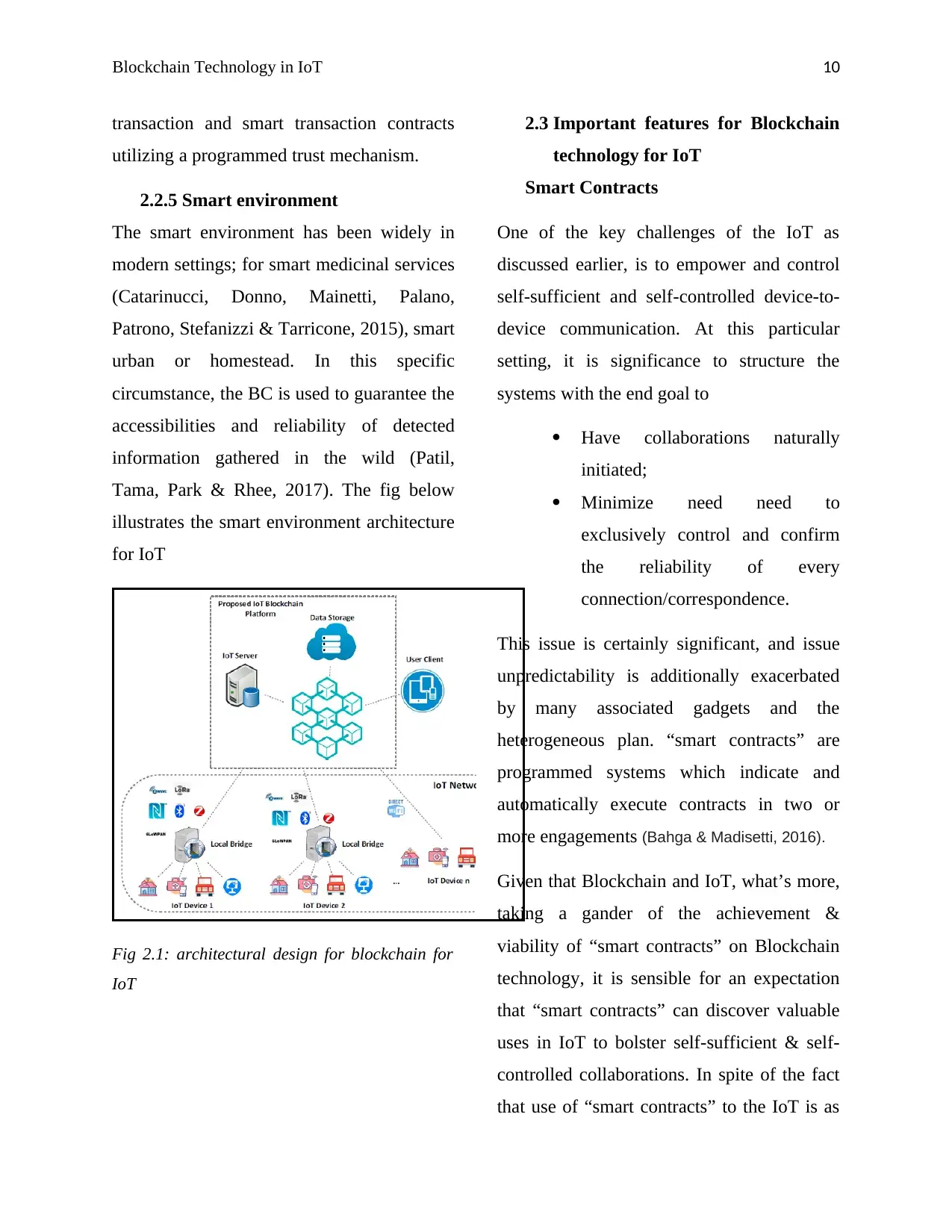
Blockchain Technology in IoT 10
transaction and smart transaction contracts
utilizing a programmed trust mechanism.
2.2.5 Smart environment
The smart environment has been widely in
modern settings; for smart medicinal services
(Catarinucci, Donno, Mainetti, Palano,
Patrono, Stefanizzi & Tarricone, 2015), smart
urban or homestead. In this specific
circumstance, the BC is used to guarantee the
accessibilities and reliability of detected
information gathered in the wild (Patil,
Tama, Park & Rhee, 2017). The fig below
illustrates the smart environment architecture
for IoT
Fig 2.1: architectural design for blockchain for
IoT
2.3 Important features for Blockchain
technology for IoT
Smart Contracts
One of the key challenges of the IoT as
discussed earlier, is to empower and control
self-sufficient and self-controlled device-to-
device communication. At this particular
setting, it is significance to structure the
systems with the end goal to
Have collaborations naturally
initiated;
Minimize need need to
exclusively control and confirm
the reliability of every
connection/correspondence.
This issue is certainly significant, and issue
unpredictability is additionally exacerbated
by many associated gadgets and the
heterogeneous plan. “smart contracts” are
programmed systems which indicate and
automatically execute contracts in two or
more engagements (Bahga & Madisetti, 2016).
Given that Blockchain and IoT, what’s more,
taking a gander of the achievement &
viability of “smart contracts” on Blockchain
technology, it is sensible for an expectation
that “smart contracts” can discover valuable
uses in IoT to bolster self-sufficient & self-
controlled collaborations. In spite of the fact
that use of “smart contracts” to the IoT is as
transaction and smart transaction contracts
utilizing a programmed trust mechanism.
2.2.5 Smart environment
The smart environment has been widely in
modern settings; for smart medicinal services
(Catarinucci, Donno, Mainetti, Palano,
Patrono, Stefanizzi & Tarricone, 2015), smart
urban or homestead. In this specific
circumstance, the BC is used to guarantee the
accessibilities and reliability of detected
information gathered in the wild (Patil,
Tama, Park & Rhee, 2017). The fig below
illustrates the smart environment architecture
for IoT
Fig 2.1: architectural design for blockchain for
IoT
2.3 Important features for Blockchain
technology for IoT
Smart Contracts
One of the key challenges of the IoT as
discussed earlier, is to empower and control
self-sufficient and self-controlled device-to-
device communication. At this particular
setting, it is significance to structure the
systems with the end goal to
Have collaborations naturally
initiated;
Minimize need need to
exclusively control and confirm
the reliability of every
connection/correspondence.
This issue is certainly significant, and issue
unpredictability is additionally exacerbated
by many associated gadgets and the
heterogeneous plan. “smart contracts” are
programmed systems which indicate and
automatically execute contracts in two or
more engagements (Bahga & Madisetti, 2016).
Given that Blockchain and IoT, what’s more,
taking a gander of the achievement &
viability of “smart contracts” on Blockchain
technology, it is sensible for an expectation
that “smart contracts” can discover valuable
uses in IoT to bolster self-sufficient & self-
controlled collaborations. In spite of the fact
that use of “smart contracts” to the IoT is as
Secure Best Marks with AI Grader
Need help grading? Try our AI Grader for instant feedback on your assignments.
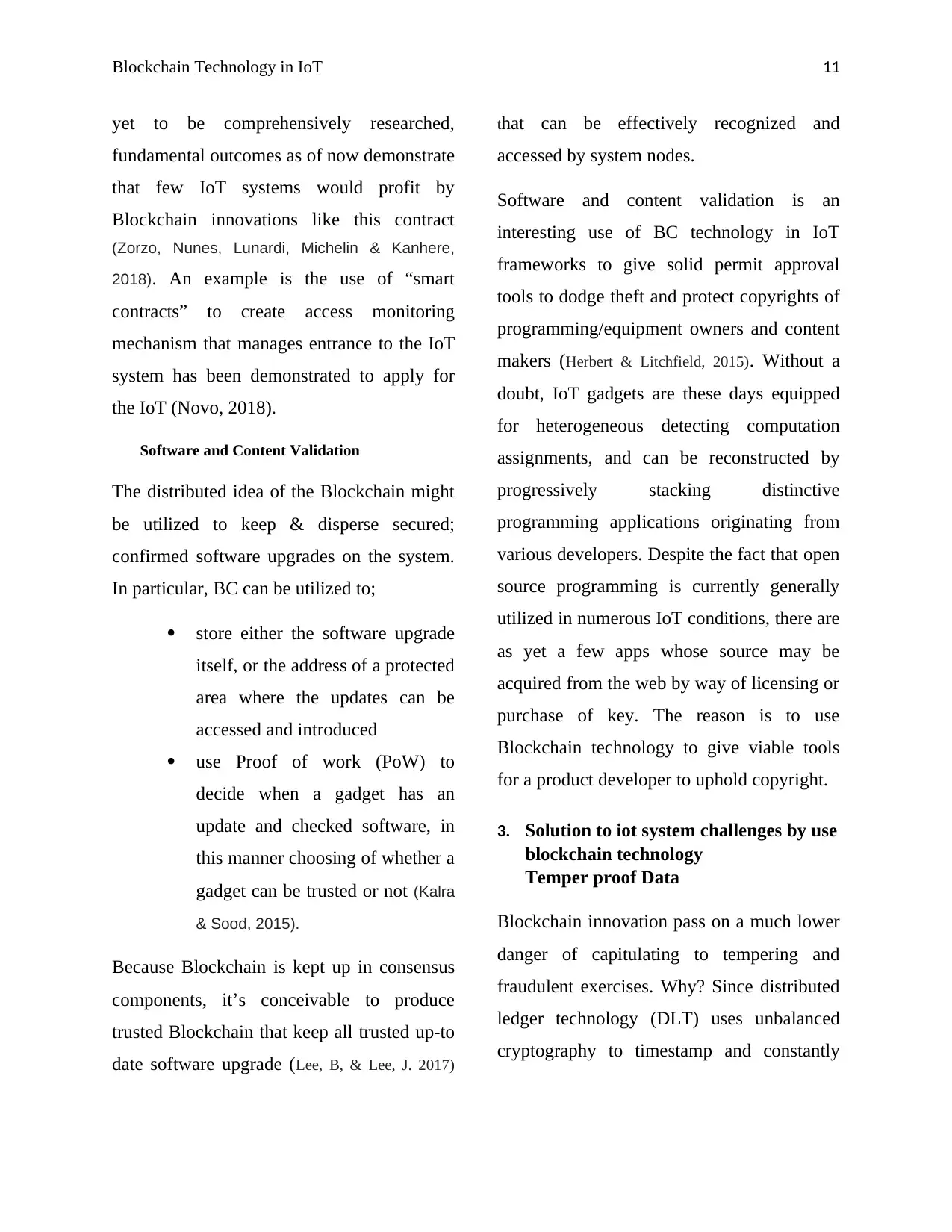
Blockchain Technology in IoT 11
yet to be comprehensively researched,
fundamental outcomes as of now demonstrate
that few IoT systems would profit by
Blockchain innovations like this contract
(Zorzo, Nunes, Lunardi, Michelin & Kanhere,
2018). An example is the use of “smart
contracts” to create access monitoring
mechanism that manages entrance to the IoT
system has been demonstrated to apply for
the IoT (Novo, 2018).
Software and Content Validation
The distributed idea of the Blockchain might
be utilized to keep & disperse secured;
confirmed software upgrades on the system.
In particular, BC can be utilized to;
store either the software upgrade
itself, or the address of a protected
area where the updates can be
accessed and introduced
use Proof of work (PoW) to
decide when a gadget has an
update and checked software, in
this manner choosing of whether a
gadget can be trusted or not (Kalra
& Sood, 2015).
Because Blockchain is kept up in consensus
components, it’s conceivable to produce
trusted Blockchain that keep all trusted up-to
date software upgrade (Lee, B, & Lee, J. 2017)
that can be effectively recognized and
accessed by system nodes.
Software and content validation is an
interesting use of BC technology in IoT
frameworks to give solid permit approval
tools to dodge theft and protect copyrights of
programming/equipment owners and content
makers (Herbert & Litchfield, 2015). Without a
doubt, IoT gadgets are these days equipped
for heterogeneous detecting computation
assignments, and can be reconstructed by
progressively stacking distinctive
programming applications originating from
various developers. Despite the fact that open
source programming is currently generally
utilized in numerous IoT conditions, there are
as yet a few apps whose source may be
acquired from the web by way of licensing or
purchase of key. The reason is to use
Blockchain technology to give viable tools
for a product developer to uphold copyright.
3. Solution to iot system challenges by use
blockchain technology
Temper proof Data
Blockchain innovation pass on a much lower
danger of capitulating to tempering and
fraudulent exercises. Why? Since distributed
ledger technology (DLT) uses unbalanced
cryptography to timestamp and constantly
yet to be comprehensively researched,
fundamental outcomes as of now demonstrate
that few IoT systems would profit by
Blockchain innovations like this contract
(Zorzo, Nunes, Lunardi, Michelin & Kanhere,
2018). An example is the use of “smart
contracts” to create access monitoring
mechanism that manages entrance to the IoT
system has been demonstrated to apply for
the IoT (Novo, 2018).
Software and Content Validation
The distributed idea of the Blockchain might
be utilized to keep & disperse secured;
confirmed software upgrades on the system.
In particular, BC can be utilized to;
store either the software upgrade
itself, or the address of a protected
area where the updates can be
accessed and introduced
use Proof of work (PoW) to
decide when a gadget has an
update and checked software, in
this manner choosing of whether a
gadget can be trusted or not (Kalra
& Sood, 2015).
Because Blockchain is kept up in consensus
components, it’s conceivable to produce
trusted Blockchain that keep all trusted up-to
date software upgrade (Lee, B, & Lee, J. 2017)
that can be effectively recognized and
accessed by system nodes.
Software and content validation is an
interesting use of BC technology in IoT
frameworks to give solid permit approval
tools to dodge theft and protect copyrights of
programming/equipment owners and content
makers (Herbert & Litchfield, 2015). Without a
doubt, IoT gadgets are these days equipped
for heterogeneous detecting computation
assignments, and can be reconstructed by
progressively stacking distinctive
programming applications originating from
various developers. Despite the fact that open
source programming is currently generally
utilized in numerous IoT conditions, there are
as yet a few apps whose source may be
acquired from the web by way of licensing or
purchase of key. The reason is to use
Blockchain technology to give viable tools
for a product developer to uphold copyright.
3. Solution to iot system challenges by use
blockchain technology
Temper proof Data
Blockchain innovation pass on a much lower
danger of capitulating to tempering and
fraudulent exercises. Why? Since distributed
ledger technology (DLT) uses unbalanced
cryptography to timestamp and constantly
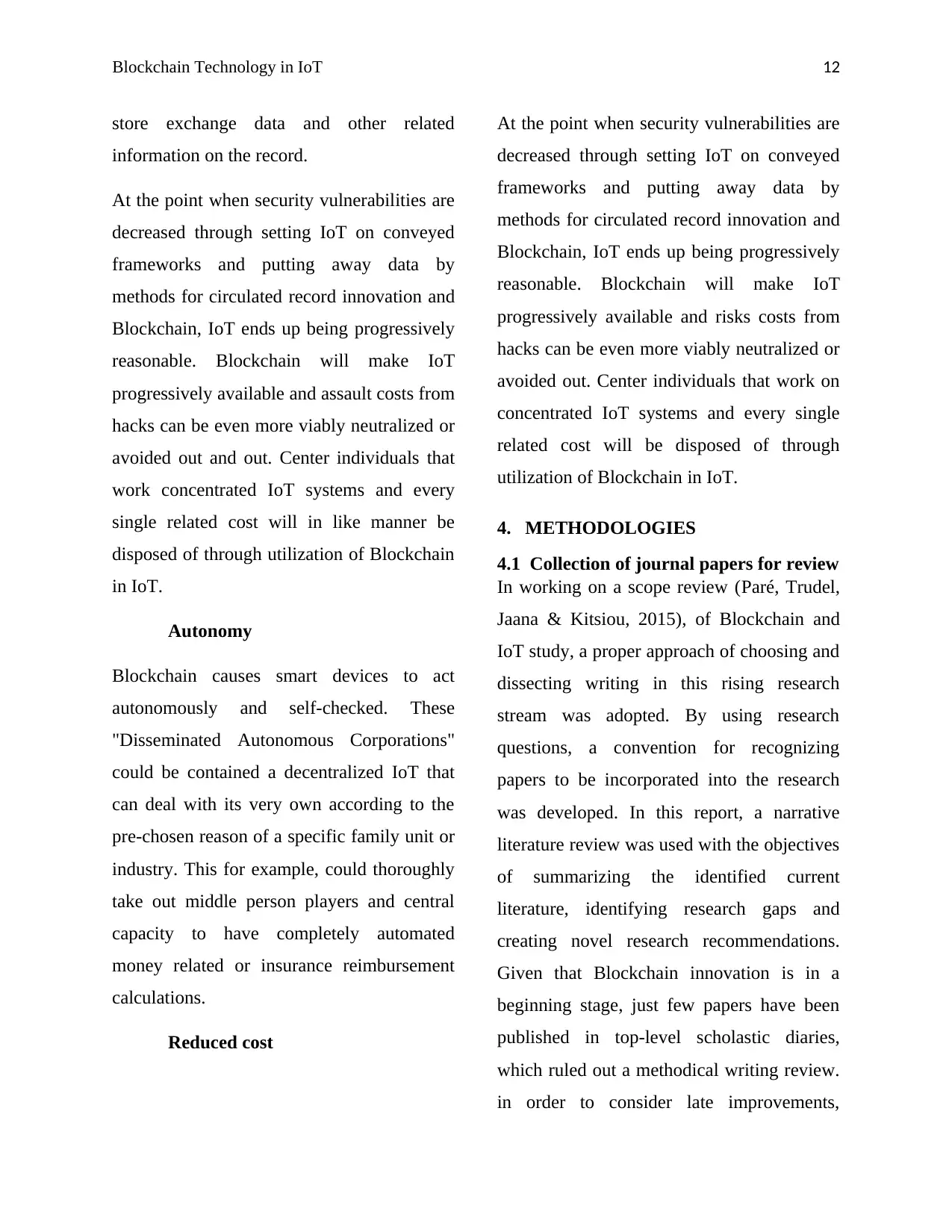
Blockchain Technology in IoT 12
store exchange data and other related
information on the record.
At the point when security vulnerabilities are
decreased through setting IoT on conveyed
frameworks and putting away data by
methods for circulated record innovation and
Blockchain, IoT ends up being progressively
reasonable. Blockchain will make IoT
progressively available and assault costs from
hacks can be even more viably neutralized or
avoided out and out. Center individuals that
work concentrated IoT systems and every
single related cost will in like manner be
disposed of through utilization of Blockchain
in IoT.
Autonomy
Blockchain causes smart devices to act
autonomously and self-checked. These
"Disseminated Autonomous Corporations"
could be contained a decentralized IoT that
can deal with its very own according to the
pre-chosen reason of a specific family unit or
industry. This for example, could thoroughly
take out middle person players and central
capacity to have completely automated
money related or insurance reimbursement
calculations.
Reduced cost
At the point when security vulnerabilities are
decreased through setting IoT on conveyed
frameworks and putting away data by
methods for circulated record innovation and
Blockchain, IoT ends up being progressively
reasonable. Blockchain will make IoT
progressively available and risks costs from
hacks can be even more viably neutralized or
avoided out. Center individuals that work on
concentrated IoT systems and every single
related cost will be disposed of through
utilization of Blockchain in IoT.
4. METHODOLOGIES
4.1 Collection of journal papers for review
In working on a scope review (Paré, Trudel,
Jaana & Kitsiou, 2015), of Blockchain and
IoT study, a proper approach of choosing and
dissecting writing in this rising research
stream was adopted. By using research
questions, a convention for recognizing
papers to be incorporated into the research
was developed. In this report, a narrative
literature review was used with the objectives
of summarizing the identified current
literature, identifying research gaps and
creating novel research recommendations.
Given that Blockchain innovation is in a
beginning stage, just few papers have been
published in top-level scholastic diaries,
which ruled out a methodical writing review.
in order to consider late improvements,
store exchange data and other related
information on the record.
At the point when security vulnerabilities are
decreased through setting IoT on conveyed
frameworks and putting away data by
methods for circulated record innovation and
Blockchain, IoT ends up being progressively
reasonable. Blockchain will make IoT
progressively available and assault costs from
hacks can be even more viably neutralized or
avoided out and out. Center individuals that
work concentrated IoT systems and every
single related cost will in like manner be
disposed of through utilization of Blockchain
in IoT.
Autonomy
Blockchain causes smart devices to act
autonomously and self-checked. These
"Disseminated Autonomous Corporations"
could be contained a decentralized IoT that
can deal with its very own according to the
pre-chosen reason of a specific family unit or
industry. This for example, could thoroughly
take out middle person players and central
capacity to have completely automated
money related or insurance reimbursement
calculations.
Reduced cost
At the point when security vulnerabilities are
decreased through setting IoT on conveyed
frameworks and putting away data by
methods for circulated record innovation and
Blockchain, IoT ends up being progressively
reasonable. Blockchain will make IoT
progressively available and risks costs from
hacks can be even more viably neutralized or
avoided out. Center individuals that work on
concentrated IoT systems and every single
related cost will be disposed of through
utilization of Blockchain in IoT.
4. METHODOLOGIES
4.1 Collection of journal papers for review
In working on a scope review (Paré, Trudel,
Jaana & Kitsiou, 2015), of Blockchain and
IoT study, a proper approach of choosing and
dissecting writing in this rising research
stream was adopted. By using research
questions, a convention for recognizing
papers to be incorporated into the research
was developed. In this report, a narrative
literature review was used with the objectives
of summarizing the identified current
literature, identifying research gaps and
creating novel research recommendations.
Given that Blockchain innovation is in a
beginning stage, just few papers have been
published in top-level scholastic diaries,
which ruled out a methodical writing review.
in order to consider late improvements,
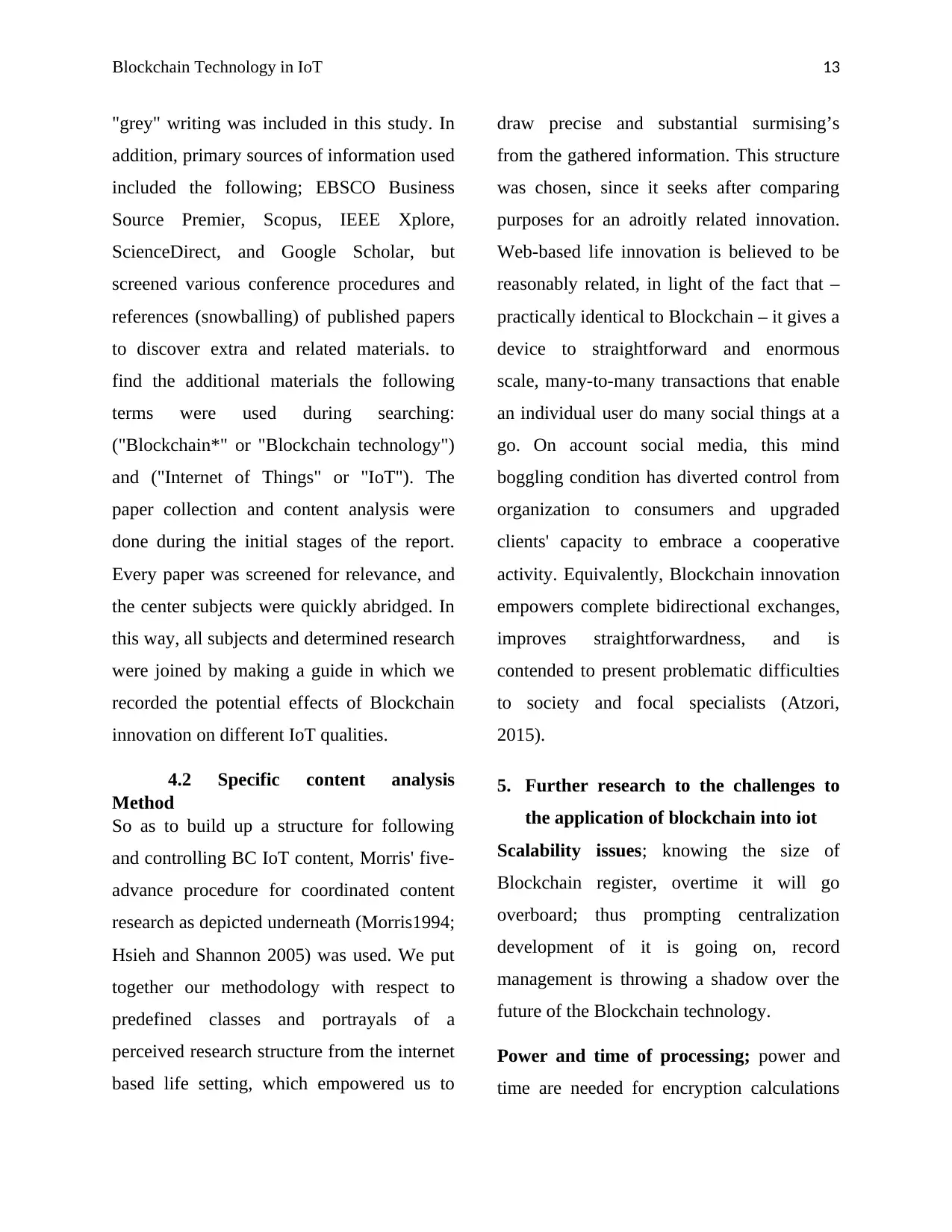
Blockchain Technology in IoT 13
"grey" writing was included in this study. In
addition, primary sources of information used
included the following; EBSCO Business
Source Premier, Scopus, IEEE Xplore,
ScienceDirect, and Google Scholar, but
screened various conference procedures and
references (snowballing) of published papers
to discover extra and related materials. to
find the additional materials the following
terms were used during searching:
("Blockchain*" or "Blockchain technology")
and ("Internet of Things" or "IoT"). The
paper collection and content analysis were
done during the initial stages of the report.
Every paper was screened for relevance, and
the center subjects were quickly abridged. In
this way, all subjects and determined research
were joined by making a guide in which we
recorded the potential effects of Blockchain
innovation on different IoT qualities.
4.2 Specific content analysis
Method
So as to build up a structure for following
and controlling BC IoT content, Morris' five-
advance procedure for coordinated content
research as depicted underneath (Morris1994;
Hsieh and Shannon 2005) was used. We put
together our methodology with respect to
predefined classes and portrayals of a
perceived research structure from the internet
based life setting, which empowered us to
draw precise and substantial surmising’s
from the gathered information. This structure
was chosen, since it seeks after comparing
purposes for an adroitly related innovation.
Web-based life innovation is believed to be
reasonably related, in light of the fact that –
practically identical to Blockchain – it gives a
device to straightforward and enormous
scale, many-to-many transactions that enable
an individual user do many social things at a
go. On account social media, this mind
boggling condition has diverted control from
organization to consumers and upgraded
clients' capacity to embrace a cooperative
activity. Equivalently, Blockchain innovation
empowers complete bidirectional exchanges,
improves straightforwardness, and is
contended to present problematic difficulties
to society and focal specialists (Atzori,
2015).
5. Further research to the challenges to
the application of blockchain into iot
Scalability issues; knowing the size of
Blockchain register, overtime it will go
overboard; thus prompting centralization
development of it is going on, record
management is throwing a shadow over the
future of the Blockchain technology.
Power and time of processing; power and
time are needed for encryption calculations
"grey" writing was included in this study. In
addition, primary sources of information used
included the following; EBSCO Business
Source Premier, Scopus, IEEE Xplore,
ScienceDirect, and Google Scholar, but
screened various conference procedures and
references (snowballing) of published papers
to discover extra and related materials. to
find the additional materials the following
terms were used during searching:
("Blockchain*" or "Blockchain technology")
and ("Internet of Things" or "IoT"). The
paper collection and content analysis were
done during the initial stages of the report.
Every paper was screened for relevance, and
the center subjects were quickly abridged. In
this way, all subjects and determined research
were joined by making a guide in which we
recorded the potential effects of Blockchain
innovation on different IoT qualities.
4.2 Specific content analysis
Method
So as to build up a structure for following
and controlling BC IoT content, Morris' five-
advance procedure for coordinated content
research as depicted underneath (Morris1994;
Hsieh and Shannon 2005) was used. We put
together our methodology with respect to
predefined classes and portrayals of a
perceived research structure from the internet
based life setting, which empowered us to
draw precise and substantial surmising’s
from the gathered information. This structure
was chosen, since it seeks after comparing
purposes for an adroitly related innovation.
Web-based life innovation is believed to be
reasonably related, in light of the fact that –
practically identical to Blockchain – it gives a
device to straightforward and enormous
scale, many-to-many transactions that enable
an individual user do many social things at a
go. On account social media, this mind
boggling condition has diverted control from
organization to consumers and upgraded
clients' capacity to embrace a cooperative
activity. Equivalently, Blockchain innovation
empowers complete bidirectional exchanges,
improves straightforwardness, and is
contended to present problematic difficulties
to society and focal specialists (Atzori,
2015).
5. Further research to the challenges to
the application of blockchain into iot
Scalability issues; knowing the size of
Blockchain register, overtime it will go
overboard; thus prompting centralization
development of it is going on, record
management is throwing a shadow over the
future of the Blockchain technology.
Power and time of processing; power and
time are needed for encryption calculations
Paraphrase This Document
Need a fresh take? Get an instant paraphrase of this document with our AI Paraphraser
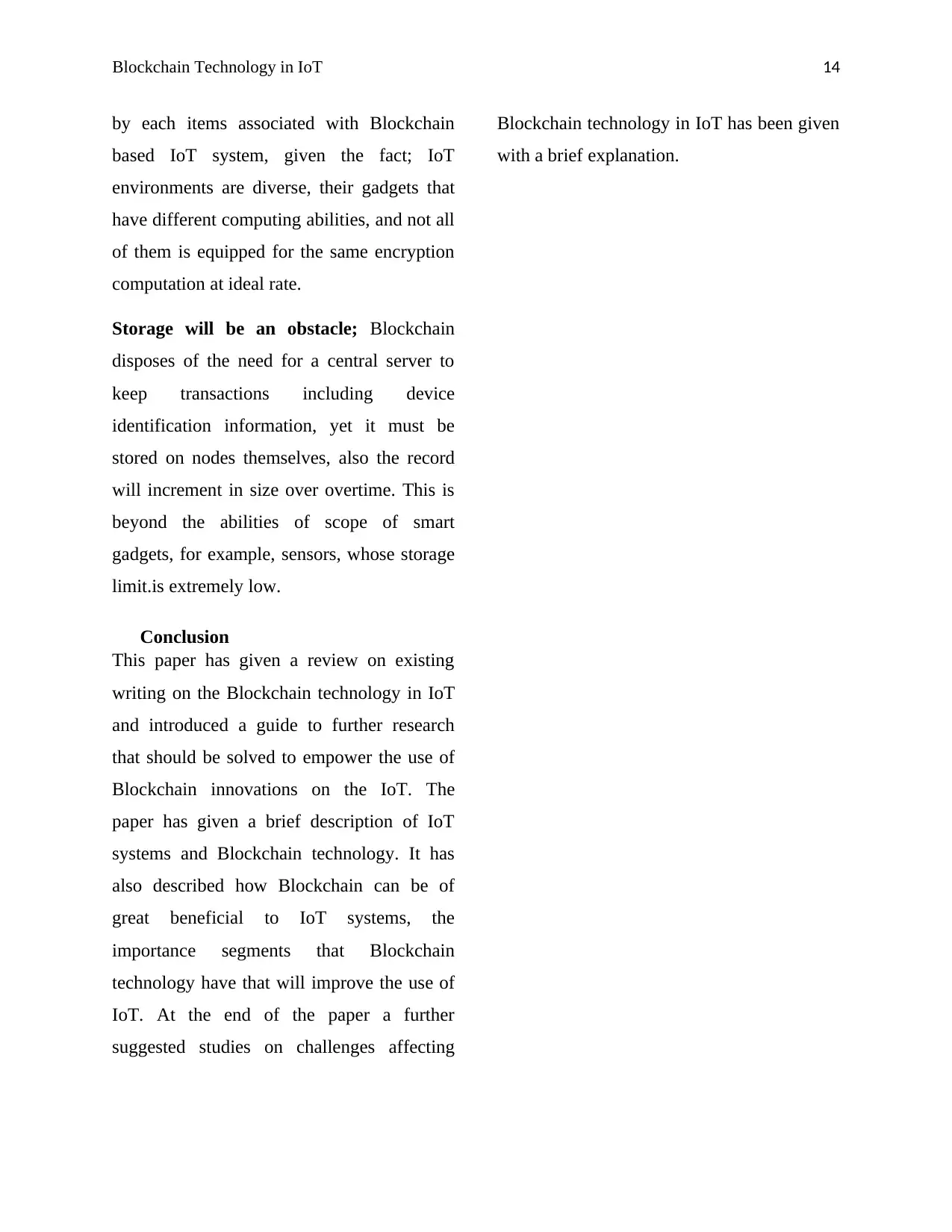
Blockchain Technology in IoT 14
by each items associated with Blockchain
based IoT system, given the fact; IoT
environments are diverse, their gadgets that
have different computing abilities, and not all
of them is equipped for the same encryption
computation at ideal rate.
Storage will be an obstacle; Blockchain
disposes of the need for a central server to
keep transactions including device
identification information, yet it must be
stored on nodes themselves, also the record
will increment in size over overtime. This is
beyond the abilities of scope of smart
gadgets, for example, sensors, whose storage
limit.is extremely low.
Conclusion
This paper has given a review on existing
writing on the Blockchain technology in IoT
and introduced a guide to further research
that should be solved to empower the use of
Blockchain innovations on the IoT. The
paper has given a brief description of IoT
systems and Blockchain technology. It has
also described how Blockchain can be of
great beneficial to IoT systems, the
importance segments that Blockchain
technology have that will improve the use of
IoT. At the end of the paper a further
suggested studies on challenges affecting
Blockchain technology in IoT has been given
with a brief explanation.
by each items associated with Blockchain
based IoT system, given the fact; IoT
environments are diverse, their gadgets that
have different computing abilities, and not all
of them is equipped for the same encryption
computation at ideal rate.
Storage will be an obstacle; Blockchain
disposes of the need for a central server to
keep transactions including device
identification information, yet it must be
stored on nodes themselves, also the record
will increment in size over overtime. This is
beyond the abilities of scope of smart
gadgets, for example, sensors, whose storage
limit.is extremely low.
Conclusion
This paper has given a review on existing
writing on the Blockchain technology in IoT
and introduced a guide to further research
that should be solved to empower the use of
Blockchain innovations on the IoT. The
paper has given a brief description of IoT
systems and Blockchain technology. It has
also described how Blockchain can be of
great beneficial to IoT systems, the
importance segments that Blockchain
technology have that will improve the use of
IoT. At the end of the paper a further
suggested studies on challenges affecting
Blockchain technology in IoT has been given
with a brief explanation.
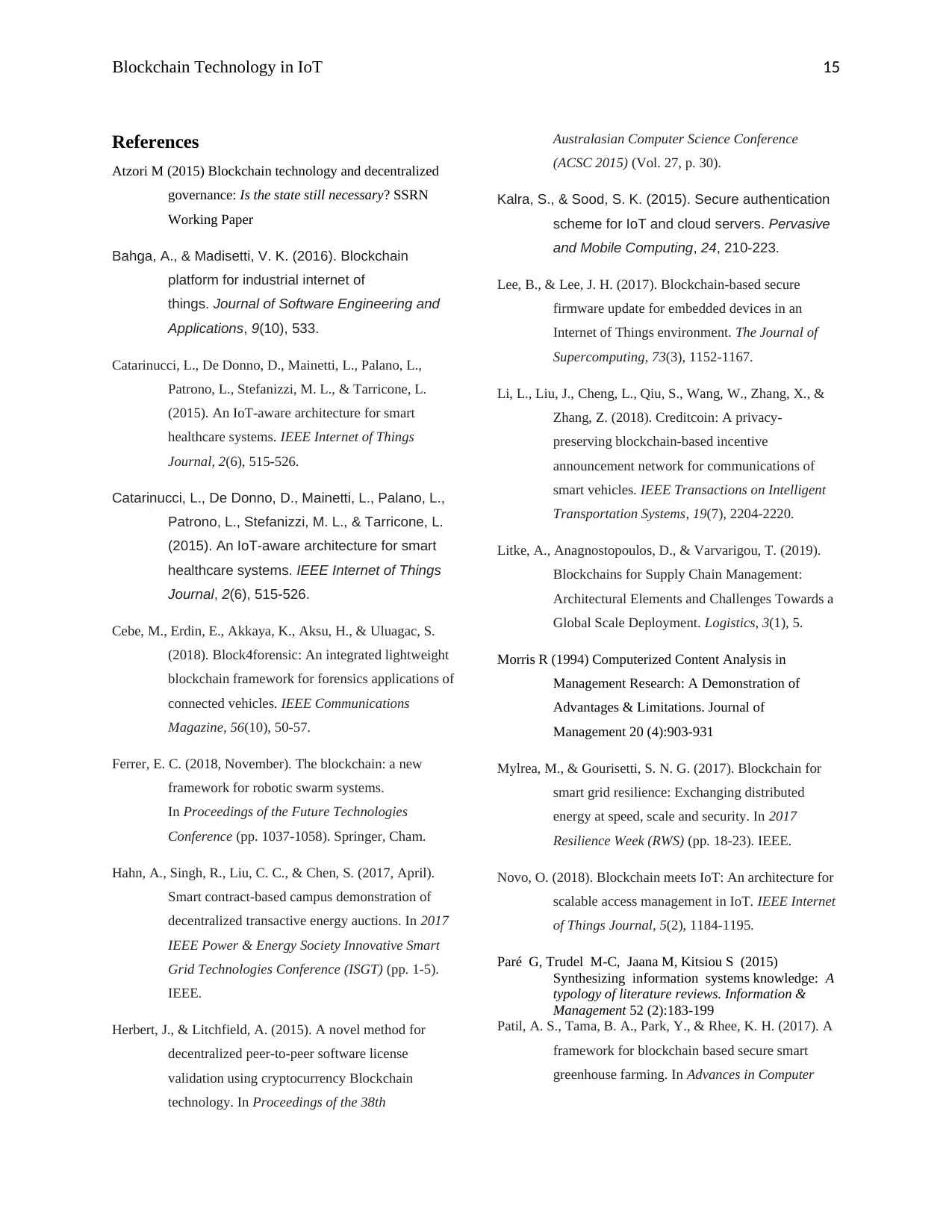
Blockchain Technology in IoT 15
References
Atzori M (2015) Blockchain technology and decentralized
governance: Is the state still necessary? SSRN
Working Paper
Bahga, A., & Madisetti, V. K. (2016). Blockchain
platform for industrial internet of
things. Journal of Software Engineering and
Applications, 9(10), 533.
Catarinucci, L., De Donno, D., Mainetti, L., Palano, L.,
Patrono, L., Stefanizzi, M. L., & Tarricone, L.
(2015). An IoT-aware architecture for smart
healthcare systems. IEEE Internet of Things
Journal, 2(6), 515-526.
Catarinucci, L., De Donno, D., Mainetti, L., Palano, L.,
Patrono, L., Stefanizzi, M. L., & Tarricone, L.
(2015). An IoT-aware architecture for smart
healthcare systems. IEEE Internet of Things
Journal, 2(6), 515-526.
Cebe, M., Erdin, E., Akkaya, K., Aksu, H., & Uluagac, S.
(2018). Block4forensic: An integrated lightweight
blockchain framework for forensics applications of
connected vehicles. IEEE Communications
Magazine, 56(10), 50-57.
Ferrer, E. C. (2018, November). The blockchain: a new
framework for robotic swarm systems.
In Proceedings of the Future Technologies
Conference (pp. 1037-1058). Springer, Cham.
Hahn, A., Singh, R., Liu, C. C., & Chen, S. (2017, April).
Smart contract-based campus demonstration of
decentralized transactive energy auctions. In 2017
IEEE Power & Energy Society Innovative Smart
Grid Technologies Conference (ISGT) (pp. 1-5).
IEEE.
Herbert, J., & Litchfield, A. (2015). A novel method for
decentralized peer-to-peer software license
validation using cryptocurrency Blockchain
technology. In Proceedings of the 38th
Australasian Computer Science Conference
(ACSC 2015) (Vol. 27, p. 30).
Kalra, S., & Sood, S. K. (2015). Secure authentication
scheme for IoT and cloud servers. Pervasive
and Mobile Computing, 24, 210-223.
Lee, B., & Lee, J. H. (2017). Blockchain-based secure
firmware update for embedded devices in an
Internet of Things environment. The Journal of
Supercomputing, 73(3), 1152-1167.
Li, L., Liu, J., Cheng, L., Qiu, S., Wang, W., Zhang, X., &
Zhang, Z. (2018). Creditcoin: A privacy-
preserving blockchain-based incentive
announcement network for communications of
smart vehicles. IEEE Transactions on Intelligent
Transportation Systems, 19(7), 2204-2220.
Litke, A., Anagnostopoulos, D., & Varvarigou, T. (2019).
Blockchains for Supply Chain Management:
Architectural Elements and Challenges Towards a
Global Scale Deployment. Logistics, 3(1), 5.
Morris R (1994) Computerized Content Analysis in
Management Research: A Demonstration of
Advantages & Limitations. Journal of
Management 20 (4):903-931
Mylrea, M., & Gourisetti, S. N. G. (2017). Blockchain for
smart grid resilience: Exchanging distributed
energy at speed, scale and security. In 2017
Resilience Week (RWS) (pp. 18-23). IEEE.
Novo, O. (2018). Blockchain meets IoT: An architecture for
scalable access management in IoT. IEEE Internet
of Things Journal, 5(2), 1184-1195.
Paré G, Trudel M-C, Jaana M, Kitsiou S (2015)
Synthesizing information systems knowledge: A
typology of literature reviews. Information &
Management 52 (2):183-199
Patil, A. S., Tama, B. A., Park, Y., & Rhee, K. H. (2017). A
framework for blockchain based secure smart
greenhouse farming. In Advances in Computer
References
Atzori M (2015) Blockchain technology and decentralized
governance: Is the state still necessary? SSRN
Working Paper
Bahga, A., & Madisetti, V. K. (2016). Blockchain
platform for industrial internet of
things. Journal of Software Engineering and
Applications, 9(10), 533.
Catarinucci, L., De Donno, D., Mainetti, L., Palano, L.,
Patrono, L., Stefanizzi, M. L., & Tarricone, L.
(2015). An IoT-aware architecture for smart
healthcare systems. IEEE Internet of Things
Journal, 2(6), 515-526.
Catarinucci, L., De Donno, D., Mainetti, L., Palano, L.,
Patrono, L., Stefanizzi, M. L., & Tarricone, L.
(2015). An IoT-aware architecture for smart
healthcare systems. IEEE Internet of Things
Journal, 2(6), 515-526.
Cebe, M., Erdin, E., Akkaya, K., Aksu, H., & Uluagac, S.
(2018). Block4forensic: An integrated lightweight
blockchain framework for forensics applications of
connected vehicles. IEEE Communications
Magazine, 56(10), 50-57.
Ferrer, E. C. (2018, November). The blockchain: a new
framework for robotic swarm systems.
In Proceedings of the Future Technologies
Conference (pp. 1037-1058). Springer, Cham.
Hahn, A., Singh, R., Liu, C. C., & Chen, S. (2017, April).
Smart contract-based campus demonstration of
decentralized transactive energy auctions. In 2017
IEEE Power & Energy Society Innovative Smart
Grid Technologies Conference (ISGT) (pp. 1-5).
IEEE.
Herbert, J., & Litchfield, A. (2015). A novel method for
decentralized peer-to-peer software license
validation using cryptocurrency Blockchain
technology. In Proceedings of the 38th
Australasian Computer Science Conference
(ACSC 2015) (Vol. 27, p. 30).
Kalra, S., & Sood, S. K. (2015). Secure authentication
scheme for IoT and cloud servers. Pervasive
and Mobile Computing, 24, 210-223.
Lee, B., & Lee, J. H. (2017). Blockchain-based secure
firmware update for embedded devices in an
Internet of Things environment. The Journal of
Supercomputing, 73(3), 1152-1167.
Li, L., Liu, J., Cheng, L., Qiu, S., Wang, W., Zhang, X., &
Zhang, Z. (2018). Creditcoin: A privacy-
preserving blockchain-based incentive
announcement network for communications of
smart vehicles. IEEE Transactions on Intelligent
Transportation Systems, 19(7), 2204-2220.
Litke, A., Anagnostopoulos, D., & Varvarigou, T. (2019).
Blockchains for Supply Chain Management:
Architectural Elements and Challenges Towards a
Global Scale Deployment. Logistics, 3(1), 5.
Morris R (1994) Computerized Content Analysis in
Management Research: A Demonstration of
Advantages & Limitations. Journal of
Management 20 (4):903-931
Mylrea, M., & Gourisetti, S. N. G. (2017). Blockchain for
smart grid resilience: Exchanging distributed
energy at speed, scale and security. In 2017
Resilience Week (RWS) (pp. 18-23). IEEE.
Novo, O. (2018). Blockchain meets IoT: An architecture for
scalable access management in IoT. IEEE Internet
of Things Journal, 5(2), 1184-1195.
Paré G, Trudel M-C, Jaana M, Kitsiou S (2015)
Synthesizing information systems knowledge: A
typology of literature reviews. Information &
Management 52 (2):183-199
Patil, A. S., Tama, B. A., Park, Y., & Rhee, K. H. (2017). A
framework for blockchain based secure smart
greenhouse farming. In Advances in Computer
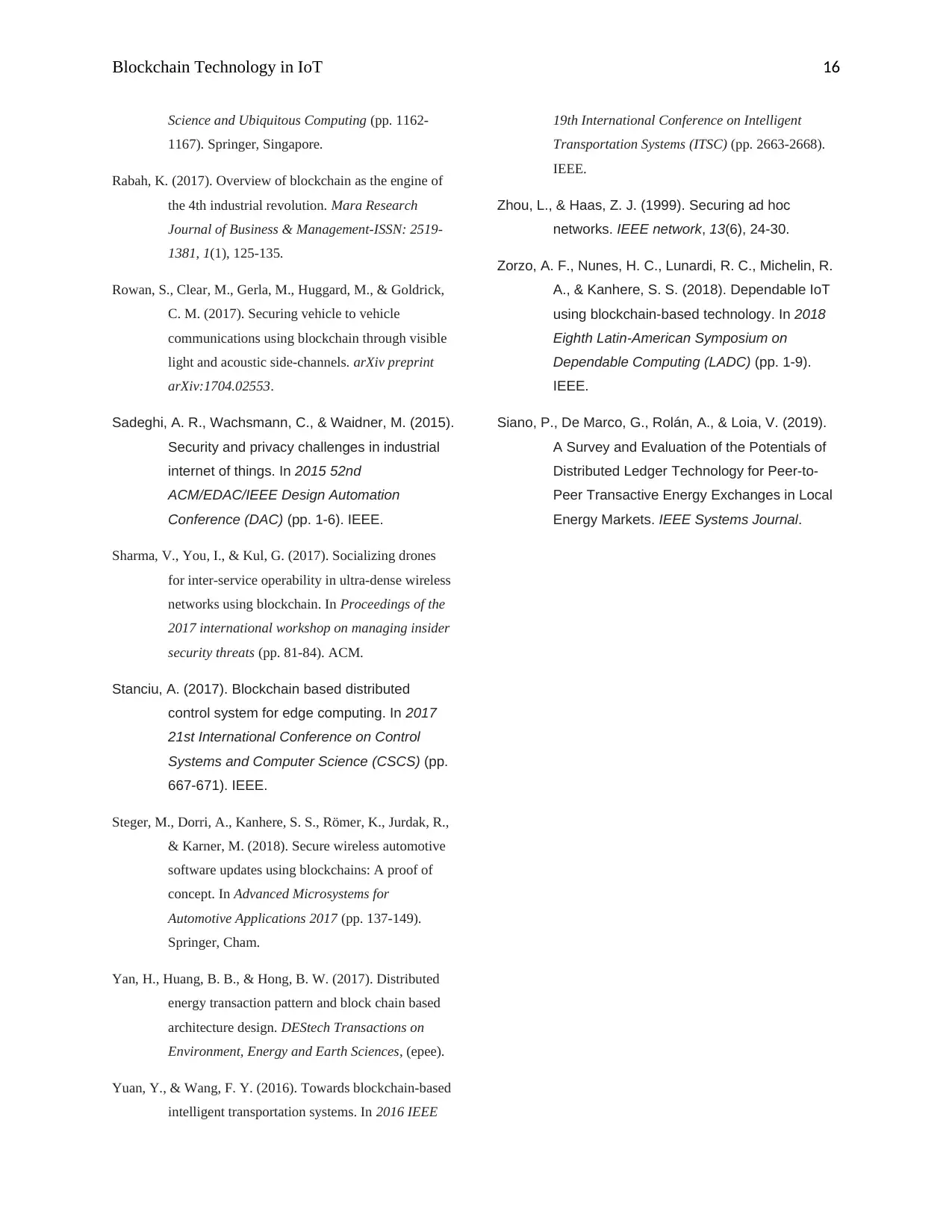
Blockchain Technology in IoT 16
Science and Ubiquitous Computing (pp. 1162-
1167). Springer, Singapore.
Rabah, K. (2017). Overview of blockchain as the engine of
the 4th industrial revolution. Mara Research
Journal of Business & Management-ISSN: 2519-
1381, 1(1), 125-135.
Rowan, S., Clear, M., Gerla, M., Huggard, M., & Goldrick,
C. M. (2017). Securing vehicle to vehicle
communications using blockchain through visible
light and acoustic side-channels. arXiv preprint
arXiv:1704.02553.
Sadeghi, A. R., Wachsmann, C., & Waidner, M. (2015).
Security and privacy challenges in industrial
internet of things. In 2015 52nd
ACM/EDAC/IEEE Design Automation
Conference (DAC) (pp. 1-6). IEEE.
Sharma, V., You, I., & Kul, G. (2017). Socializing drones
for inter-service operability in ultra-dense wireless
networks using blockchain. In Proceedings of the
2017 international workshop on managing insider
security threats (pp. 81-84). ACM.
Stanciu, A. (2017). Blockchain based distributed
control system for edge computing. In 2017
21st International Conference on Control
Systems and Computer Science (CSCS) (pp.
667-671). IEEE.
Steger, M., Dorri, A., Kanhere, S. S., Römer, K., Jurdak, R.,
& Karner, M. (2018). Secure wireless automotive
software updates using blockchains: A proof of
concept. In Advanced Microsystems for
Automotive Applications 2017 (pp. 137-149).
Springer, Cham.
Yan, H., Huang, B. B., & Hong, B. W. (2017). Distributed
energy transaction pattern and block chain based
architecture design. DEStech Transactions on
Environment, Energy and Earth Sciences, (epee).
Yuan, Y., & Wang, F. Y. (2016). Towards blockchain-based
intelligent transportation systems. In 2016 IEEE
19th International Conference on Intelligent
Transportation Systems (ITSC) (pp. 2663-2668).
IEEE.
Zhou, L., & Haas, Z. J. (1999). Securing ad hoc
networks. IEEE network, 13(6), 24-30.
Zorzo, A. F., Nunes, H. C., Lunardi, R. C., Michelin, R.
A., & Kanhere, S. S. (2018). Dependable IoT
using blockchain-based technology. In 2018
Eighth Latin-American Symposium on
Dependable Computing (LADC) (pp. 1-9).
IEEE.
Siano, P., De Marco, G., Rolán, A., & Loia, V. (2019).
A Survey and Evaluation of the Potentials of
Distributed Ledger Technology for Peer-to-
Peer Transactive Energy Exchanges in Local
Energy Markets. IEEE Systems Journal.
Science and Ubiquitous Computing (pp. 1162-
1167). Springer, Singapore.
Rabah, K. (2017). Overview of blockchain as the engine of
the 4th industrial revolution. Mara Research
Journal of Business & Management-ISSN: 2519-
1381, 1(1), 125-135.
Rowan, S., Clear, M., Gerla, M., Huggard, M., & Goldrick,
C. M. (2017). Securing vehicle to vehicle
communications using blockchain through visible
light and acoustic side-channels. arXiv preprint
arXiv:1704.02553.
Sadeghi, A. R., Wachsmann, C., & Waidner, M. (2015).
Security and privacy challenges in industrial
internet of things. In 2015 52nd
ACM/EDAC/IEEE Design Automation
Conference (DAC) (pp. 1-6). IEEE.
Sharma, V., You, I., & Kul, G. (2017). Socializing drones
for inter-service operability in ultra-dense wireless
networks using blockchain. In Proceedings of the
2017 international workshop on managing insider
security threats (pp. 81-84). ACM.
Stanciu, A. (2017). Blockchain based distributed
control system for edge computing. In 2017
21st International Conference on Control
Systems and Computer Science (CSCS) (pp.
667-671). IEEE.
Steger, M., Dorri, A., Kanhere, S. S., Römer, K., Jurdak, R.,
& Karner, M. (2018). Secure wireless automotive
software updates using blockchains: A proof of
concept. In Advanced Microsystems for
Automotive Applications 2017 (pp. 137-149).
Springer, Cham.
Yan, H., Huang, B. B., & Hong, B. W. (2017). Distributed
energy transaction pattern and block chain based
architecture design. DEStech Transactions on
Environment, Energy and Earth Sciences, (epee).
Yuan, Y., & Wang, F. Y. (2016). Towards blockchain-based
intelligent transportation systems. In 2016 IEEE
19th International Conference on Intelligent
Transportation Systems (ITSC) (pp. 2663-2668).
IEEE.
Zhou, L., & Haas, Z. J. (1999). Securing ad hoc
networks. IEEE network, 13(6), 24-30.
Zorzo, A. F., Nunes, H. C., Lunardi, R. C., Michelin, R.
A., & Kanhere, S. S. (2018). Dependable IoT
using blockchain-based technology. In 2018
Eighth Latin-American Symposium on
Dependable Computing (LADC) (pp. 1-9).
IEEE.
Siano, P., De Marco, G., Rolán, A., & Loia, V. (2019).
A Survey and Evaluation of the Potentials of
Distributed Ledger Technology for Peer-to-
Peer Transactive Energy Exchanges in Local
Energy Markets. IEEE Systems Journal.
1 out of 16
Related Documents
Your All-in-One AI-Powered Toolkit for Academic Success.
+13062052269
info@desklib.com
Available 24*7 on WhatsApp / Email
![[object Object]](/_next/static/media/star-bottom.7253800d.svg)
Unlock your academic potential
© 2024 | Zucol Services PVT LTD | All rights reserved.




